

30 Examples: How to Conclude a Presentation (Effective Closing Techniques)
By Status.net Editorial Team on March 4, 2024 — 9 minutes to read
Ending a presentation on a high note is a skill that can set you apart from the rest. It’s the final chance to leave an impact on your audience, ensuring they walk away with the key messages embedded in their minds. This moment is about driving your points home and making sure they resonate. Crafting a memorable closing isn’t just about summarizing key points, though that’s part of it, but also about providing value that sticks with your listeners long after they’ve left the room.
Crafting Your Core Message
To leave a lasting impression, your presentation’s conclusion should clearly reflect your core message. This is your chance to reinforce the takeaways and leave the audience thinking about your presentation long after it ends.
Identifying Key Points
Start by recognizing what you want your audience to remember. Think about the main ideas that shaped your talk. Make a list like this:
- The problem your presentation addresses.
- The evidence that supports your argument.
- The solution you propose or the action you want the audience to take.
These key points become the pillars of your core message.
Contextualizing the Presentation
Provide context by briefly relating back to the content of the whole presentation. For example:
- Reference a statistic you shared in the opening, and how it ties into the conclusion.
- Mention a case study that underlines the importance of your message.
Connecting these elements gives your message cohesion and makes your conclusion resonate with the framework of your presentation.
30 Example Phrases: How to Conclude a Presentation
- 1. “In summary, let’s revisit the key takeaways from today’s presentation.”
- 2. “Thank you for your attention. Let’s move forward together.”
- 3. “That brings us to the end. I’m open to any questions you may have.”
- 4. “I’ll leave you with this final thought to ponder as we conclude.”
- 5. “Let’s recap the main points before we wrap up.”
- 6. “I appreciate your engagement. Now, let’s turn these ideas into action.”
- 7. “We’ve covered a lot today. To conclude, remember these crucial points.”
- 8. “As we reach the end, I’d like to emphasize our call to action.”
- 9. “Before we close, let’s quickly review what we’ve learned.”
- 10. “Thank you for joining me on this journey. I look forward to our next steps.”
- 11. “In closing, I’d like to thank everyone for their participation.”
- 12. “Let’s conclude with a reminder of the impact we can make together.”
- 13. “To wrap up our session, here’s a brief summary of our discussion.”
- 14. “I’m grateful for the opportunity to present to you. Any final thoughts?”
- 15. “And that’s a wrap. I welcome any final questions or comments.”
- 16. “As we conclude, let’s remember the objectives we’ve set today.”
- 17. “Thank you for your time. Let’s apply these insights to achieve success.”
- 18. “In conclusion, your feedback is valuable, and I’m here to listen.”
- 19. “Before we part, let’s take a moment to reflect on our key messages.”
- 20. “I’ll end with an invitation for all of us to take the next step.”
- 21. “As we close, let’s commit to the goals we’ve outlined today.”
- 22. “Thank you for your attention. Let’s keep the conversation going.”
- 23. “In conclusion, let’s make a difference, starting now.”
- 24. “I’ll leave you with these final words to consider as we end our time together.”
- 25. “Before we conclude, remember that change starts with our actions today.”
- 26. “Thank you for the lively discussion. Let’s continue to build on these ideas.”
- 27. “As we wrap up, I encourage you to reach out with any further questions.”
- 28. “In closing, I’d like to express my gratitude for your valuable input.”
- 29. “Let’s conclude on a high note and take these learnings forward.”
- 30. “Thank you for your time today. Let’s end with a commitment to progress.”
Summarizing the Main Points
When you reach the end of your presentation, summarizing the main points helps your audience retain the important information you’ve shared. Crafting a memorable summary enables your listeners to walk away with a clear understanding of your message.
Effective Methods of Summarization
To effectively summarize your presentation, you need to distill complex information into concise, digestible pieces. Start by revisiting the overarching theme of your talk and then narrow down to the core messages. Use plain language and imagery to make the enduring ideas stick. Here are some examples of how to do this:
- Use analogies that relate to common experiences to recap complex concepts.
- Incorporate visuals or gestures that reinforce your main arguments.
The Rule of Three
The Rule of Three is a classic writing and communication principle. It means presenting ideas in a trio, which is a pattern that’s easy for people to understand and remember. For instance, you might say, “Our plan will save time, cut costs, and improve quality.” This structure has a pleasing rhythm and makes the content more memorable. Some examples include:
- “This software is fast, user-friendly, and secure.”
- Pointing out a product’s “durability, affordability, and eco-friendliness.”
Reiterating the Main Points
Finally, you want to circle back to the key takeaways of your presentation. Rephrase your main points without introducing new information. This reinforcement supports your audience’s memory and understanding of the material. You might summarize key takeaways like this:
- Mention the problem you addressed, the solution you propose, and the benefits of this solution.
- Highlighting the outcomes of adopting your strategy: higher efficiency, greater satisfaction, and increased revenue.
Creating a Strong Conclusion
The final moments of your presentation are your chance to leave your audience with a powerful lasting impression. A strong conclusion is more than just summarizing—it’s your opportunity to invoke thought, inspire action, and make your message memorable.
Incorporating a Call to Action
A call to action is your parting request to your audience. You want to inspire them to take a specific action or think differently as a result of what they’ve heard. To do this effectively:
- Be clear about what you’re asking.
- Explain why their action is needed.
- Make it as simple as possible for them to take the next steps.
Example Phrases:
- “Start making a difference today by…”
- “Join us in this effort by…”
- “Take the leap and commit to…”
Leaving a Lasting Impression
End your presentation with something memorable. This can be a powerful quote, an inspirational statement, or a compelling story that underscores your main points. The goal here is to resonate with your audience on an emotional level so that your message sticks with them long after they leave.
- “In the words of [Influential Person], ‘…'”
- “Imagine a world where…”
- “This is more than just [Topic]; it’s about…”
Enhancing Audience Engagement
To hold your audience’s attention and ensure they leave with a lasting impression of your presentation, fostering interaction is key.
Q&A Sessions
It’s important to integrate a Q&A session because it allows for direct communication between you and your audience. This interactive segment helps clarify any uncertainties and encourages active participation. Plan for this by designating a time slot towards the end of your presentation and invite questions that promote discussion.
- “I’d love to hear your thoughts; what questions do you have?”
- “Let’s dive into any questions you might have. Who would like to start?”
- “Feel free to ask any questions, whether they’re clarifications or deeper inquiries about the topic.”
Encouraging Audience Participation
Getting your audience involved can transform a good presentation into a great one. Use open-ended questions that provoke thought and allow audience members to reflect on how your content relates to them. Additionally, inviting volunteers to participate in a demonstration or share their experiences keeps everyone engaged and adds a personal touch to your talk.
- “Could someone give me an example of how you’ve encountered this in your work?”
- “I’d appreciate a volunteer to help demonstrate this concept. Who’s interested?”
- “How do you see this information impacting your daily tasks? Let’s discuss!”
Delivering a Persuasive Ending
At the end of your presentation, you have the power to leave a lasting impact on your audience. A persuasive ending can drive home your key message and encourage action.
Sales and Persuasion Tactics
When you’re concluding a presentation with the goal of selling a product or idea, employ carefully chosen sales and persuasion tactics. One method is to summarize the key benefits of your offering, reminding your audience why it’s important to act. For example, if you’ve just presented a new software tool, recap how it will save time and increase productivity. Another tactic is the ‘call to action’, which should be clear and direct, such as “Start your free trial today to experience the benefits first-hand!” Furthermore, using a touch of urgency, like “Offer expires soon!”, can nudge your audience to act promptly.
Final Impressions and Professionalism
Your closing statement is a chance to solidify your professional image and leave a positive impression. It’s important to display confidence and poise. Consider thanking your audience for their time and offering to answer any questions. Make sure to end on a high note by summarizing your message in a concise and memorable way. If your topic was on renewable energy, you might conclude by saying, “Let’s take a leap towards a greener future by adopting these solutions today.” This reinforces your main points and encourages your listeners to think or act differently when they leave.
Frequently Asked Questions
What are some creative strategies for ending a presentation memorably.
To end your presentation in a memorable way, consider incorporating a call to action that engages your audience to take the next step. Another strategy is to finish with a thought-provoking question or a surprising fact that resonates with your listeners.
Can you suggest some powerful quotes suitable for concluding a presentation?
Yes, using a quote can be very effective. For example, Maya Angelou’s “People will forget what you said, people will forget what you did, but people will never forget how you made them feel,” can reinforce the emotional impact of your presentation.
What is an effective way to write a conclusion that summarizes a presentation?
An effective conclusion should recap the main points succinctly, highlighting what you want your audience to remember. A good way to conclude is by restating your thesis and then briefly summarizing the supporting points you made.
As a student, how can I leave a strong impression with my presentation’s closing remarks?
To leave a strong impression, consider sharing a personal anecdote related to your topic that demonstrates passion and conviction. This helps humanize your content and makes the message more relatable to your audience.
How can I appropriately thank my audience at the close of my presentation?
A simple and sincere expression of gratitude is always appropriate. You might say, “Thank you for your attention and engagement today,” to convey appreciation while also acknowledging their participation.
What are some examples of a compelling closing sentence in a presentation?
A compelling closing sentence could be something like, “Together, let’s take the leap towards a greener future,” if you’re presenting on sustainability. This sentence is impactful, calls for united action, and leaves your audience with a clear message.
- How to Build Rapport: Effective Techniques
- Active Listening (Techniques, Examples, Tips)
- Effective Nonverbal Communication in the Workplace (Examples)
- What is Problem Solving? (Steps, Techniques, Examples)
- 2 Examples of an Effective and Warm Letter of Welcome
- 8 Examples of Effective Interview Confirmation Emails
- Slidesgo School
- Presentation Tips
How to End Your Presentation: Tips for Your Grand Finale

You have just created the most amazing presentation ever. You have written a touching speech and you are designing your last slides… Oh, wait. How to end your pitch? Sometimes people get distracted. Don’t panic. You don’t need to read Aristotle’s Rhetoric to close your presentation in an effective way. In this tutorial, we will teach you some tips to influence your listeners and to get new clients, investors, students… They’ll love you and your product or service!
Summarize and show a sneak peek
Make a lasting impact: quotes, use emotions to persuade your audience, involve your audience, add a “thanks” slide.
Just before saying “thanks” and “goodbye”, it’s time to summarize the contents of your presentation… and give something new to your audience. Repetition can be a good idea! In this case, it will help your listeners. Thanks to it, they will manage to understand the global structure of your speech, if they didn’t before! In addition, if they had doubts or didn’t understand a section properly, their questions will be immediately answered. Before or after talking about the main points of your presentation, give your audience something that will make them want to know more about your product or service. In this respect you give them an opportunity to see something before it is officially available.

This is a sneak peek. In Slidesgo, we add a special template in some of our Marketing themes . You could, for example, add a video showing the features of your product. Make it visual, interesting and you will thrill your audience! → Are you fascinated by the smart design of this News Agency Template yet? Give it a go!
It’s usual to add a quote to your presentation. Recalling the perfect sentence by an authority is great when you want to persuade or to make a great impact in your listeners. By authority, we refer to someone who is a specialist in an area or to someone who is pretty famous for his or her work, intelligence… In the same way, you can also use closing lines of books or movies. They also have a great impact! Have you ever watched Some Like It Hot? The very last sentence pronounced in this movie, became one of the most well known and quoted lines in history. When Jerry confesses that he is a man, Osgood states: “Well, nobody’s perfect.” Let’s use a famous quote in your presentation. Choose a sentence that represents your passion and that triggers a pleasant feeling in your audience. Talking about effort is always a good idea. The same can be applied to optimism, as it is a contagious emotion!

Get this quote as an example. It is short, concise and it was pronounced by someone who is famous and successful! → Did you like this energetic World After Coronavirus Template ? Get it for free!
You have explained all the technical details of your company and your product or service. Now, let's add some emotive touches to what you want to say. Of course, it’s something that you can use during the whole presentation, but ending in an emotional way will be very effective. Our memory works better when emotions are around. We remember quite clearly moments of pure joy, moments of adventure or periods of grief, but you may not remember what you ate a week ago. There were no feelings attached to food (usually!). Let’s have a look at the following slide:
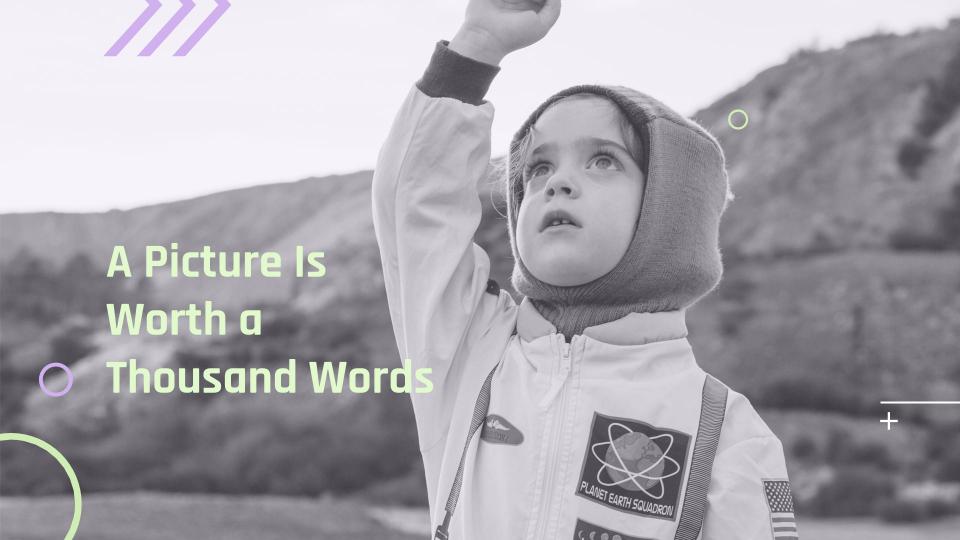
It clearly evokes a feeling of strength, self-improvement and self-realization. It seems that the girl can achieve anything she wants! It’s warm, lovely. This image tells a story related to feelings. Use this sort of image, and match it with your words. Talk about the importance of diversity and how this will result in a better society, for example. Talking about words themselves, don’t forget to use inclusive pronouns: we, us, our. Make yourself part of your audience. This way, they will feel as part of your team! → Use now this Girls in Science Template !
If you don’t allow your audience to take part in your presentation, in what you say, they can get easily distracted. Remember that you prepare your presentation or you give a speech having your listeners, clients or potential investors in mind. It’s not something that you prepare for you! What should you do to involve your audience? We have talked about using “we” in the previous section. Employ “you” as well! This way, they’ll feel that you are directing your attention to them, that you want them to take part in what you are saying. OK, linguistically speaking it’s a good tip. But… Is there anything else that we can do? Of course! Asking them questions or rising a challenge can be great for doing so. Imagine this situation: you are just finishing and some of them have stopped paying attention… but you have a question ready for them! You can use interactive templates in such cases. They are pretty uncommon and funny, so your presentation will turn into a game!
→ Use this Social-Emotional Learning Template now!
It may seem trivial, but saying thanks at the end of your presentation is important. Why? Well, this serves as a clear indicator that tells your audience that you have finished. If you try to end, for example, with a summary, without any “thanks” slide, it can be confusing. This is a customary thing to do. We all understand that, with “thanks”, the presentation is over. There are, of course, other important reasons to use this magical word! Always remember that your listeners have devoted part of their valuable time listening to you and paying attention to your message. Saying thanks is a time-honoured practice. In fact, being polite is the way to persuade your listeners.

Try using a slide to say “thanks”. Make use of a beautiful theme font and make the word stand out! Apart from that, you could also use this slide to provide your contact details. They know that your presentation is coming to an end, so they will surely write down your email or your telephone number to contact you! → Do you like this Wedding Template ? Download and edit it now, it’s free! The key to have a grand finale is letting your audience understand that you care about them: say thanks, summarize the contents so they are easier to understand. Connect with their emotions! Practice, practice and practice. These tips will help you become as good as Martin Luther King in public speaking! If you need more free Google Slides themes and PowerPoint templates , you can visit our website! We have beautiful and useful designs for you!

Do you find this article useful?
Related tutorials.

Entrepreneurship and Personal Development Hackathon: The magic of learning by doing
The new generations show us that the way of learning has completely changed. Now more than ever, it is key to encourage and support the development of social and entrepreneurial skills in children so that they can become more actively involved in their learning. Participating in creative projects and collaborative activities allows them to explore and learn on their own about topics that interest them, solve their problems with more autonomy, and work better in teams.This idea was the motivation behind the Junior Entrepreneurship and Personal Development Hackathon organized by Slidesgo in collaboration with Genyus School. At this event, more than 150 children had...

Work faster, teach better: boost your skills with Slidesgo Academy
We truly believe that every educator has what it takes to be a fantastic presenter, but we’re also aware of the time it takes to hone these skills. Enter Slidesgo with a great, fast solution: Slidesgo Academy.At this empowering and encouraging platform, we’ve partnered with veteran classroom educators to compile the best tips that will enable you to create engaging, eye-catching, and top-quality presentations for your students and fellow educators. You’ll surprise yourself with how quickly you can craft lessons that engage and excite. Join us as a student, and become the best teacher you can be!

7 tips to create a positive classroom culture
No matter if it's been ages since you last stepped into a classroom or just a long time ago―there’s probably a particular learning experience you often find yourself thinking about. Maybe it was a passionate teacher who kept the whole class engaged, or perhaps a classmate who lent you a hand with a tricky topic. Positive classroom experiences do leave a lasting mark on us, so it makes perfect sense that people leading a classroom aim to create the finest possible learning setting. In this article, we’ll share some tips to help you turn a regular classroom into a positive space.

How to create a word cloud in Google Slides
There are many ways to improve your Google Slides presentation. From choosing the right font to finding the right template, good presentations keep an audience engaged and convey a message in a clear way.Knowing how to visualize data in a slideshow is one of those actions that have a huge impact on the success of a presentation. At the end of the day, plain data fails to motivate decisions as effectively as clear insights do. This is when powerful visual tools like word clouds step in. Let us tell you all about them.
Like what you're reading?
How to end a presentation in 10 memorable ways
Get your team on prezi – watch this on demand video.

Michael Lee August 28, 2019
You’ve just delivered a captivating presentation that had people hanging on your every word. Now you need to wrap it up and leave a lasting impression. After all, studies show people have an easier time recalling information presented at the beginning and end. So, you might be asking yourself: “How can I end my presentation in a memorable way?”
It’s common to field questions at the end, but this can make your presentation less memorable and derail your message. If you’re wondering how to end a presentation in a way that will engage your audience, try one of the 10 examples below.
Also, take notes on additional tips and tricks that can help you end your presentation with confidence and style.
1. Tell a compelling story
Offering a compelling story is a powerful way to end your presentation, especially if it’s a personal one. Personal stories help create empathy with the audience, which makes it easier to get your key message across. Also, it is a creative way to summarize your main points and make sure that your message has a personal feel to it. As an example, health and wellness presenters will often wrap up presentations with a story about a personal health scare and how a change in their lifestyle helped them live a better life.
Try using Prezi — and in particular, the animations — to create a presentation that promotes storytelling and keeps your audience interested. By zooming in and out at specific points, you can visualize your story as you tell it, which will help people remember your presentation. Check out our previous Prezi Awards winners for great examples of visual storytelling in action.
2. Add a call to action
It’s not enough to assume your presentation will make people want to do something. Instead, you should be clear by including a call to action (CTA) at the end of your speech. Keep in mind that the CTA needs to be easily achievable and also relevant to your content. If people need to jump through hoops to do the action, then nobody will bother. Similarly, if you spent the entire time sharing a deeply personal story, then it wouldn’t be appropriate to ask people to buy your product.
Some examples of captivating CTAs:
“Start your journey towards X today!”
“Make a change with X!”
“Create a better tomorrow for yourself with X!”
“Sign up now & get exclusive insights!”
When crafting your CTA, think about what is the next step you want your audience to take and why they would want to take it. This way, you can tie an actionable step with compelling reasoning.
3. Drop a surprising fact
You’ve followed the science behind good public speaking and have been able to maintain eye contact with your audience during your presentation. Now consider finishing your presentation with a surprising fact. Facts with statistical numbers work well to engage your audience, and you’ll likely find a variety of facts related to your presentation topic if you search online.
By finishing your presentation off with a shocking number or fact, people will be more likely to remember your presentation. Also, if you incorporate a fact that can create some sort of emotion, whether positive or shocking or else, your presentation will become even more memorable. However, be aware to share something that creates an emotion you want your audience to be feeling.
Tip: Be careful not to dump a bunch of numbers on the screen. Use the power of visuals to convey complex information in an impactful way.
4. Share a quote
Using an interesting and relevant quote is a great way to end your presentation. However, to make sure the quote stays with your audience long after they leave the room, choose one they don’t hear all the time. You can ensure your quote is fresh by looking for one from a modern leader or personality rather than one from a historical figure.
Just make sure your quote goes with the theme of your presentation. Additionally, if you can tie the quote back to a personal story, you’ll leave your audience with a better grasp of the key points of your presentation.
Examples of powerful quotes you can leave your audience with:
“Don’t worry about failure. You only have to be right once.” – Drew Houston, co-founder, and CEO of Dropbox
“Don’t ever make decisions based on fear. Make decisions based on hope and possibility.” – Michelle Obama, the former first lady of the United States
“If you don’t like something, change it. If you can’t change it, change your attitude.” – Maya Angelou, writer
5. Use the rule of three
The rule of three is a simple and powerful way of communicating. The idea behind the rule of three is that it’s easier for the audience to remember concepts, ideas, and beliefs when they’re presented in patterns of three. You can find the rule of three almost everywhere you look.
As a real-life example of ending a presentation with the rule of three, Dianna Cohen, co-founder of the Plastic Pollution Coalition, wraps up her speeches on plastic pollution by stating, “We can save our oceans, save our planet, and save ourselves.”

6. Refer back to your opening statement
If you’re wondering how to end a presentation that’s long or includes complicated information, try referencing your opening statement. This is also a good way to signal to your audience that things are coming to a close. By coming back to the opening statement, your audience will have a better understanding of how the different arguments all tie in together, to sum up, the message you are trying to deliver.
To make it more interesting, you can also try injecting some humor or adding some extra insight to your message. However, don’t just mention your opening statement but also show how your opening statement and the points you raised are linked to the closing argument.
7. Ask a rhetorical question
Just because you don’t want to end your presentation slide with the audience’s questions doesn’t mean you can’t finish your speech with any questions at all. Consider wrapping things up by asking your audience a rhetorical question. The key thing is to make sure the question is a strong one, as you want your audience to think about the question after they leave.
At the end of your presentation, you can simply add, “is x the right answer to the question? That’s for you to answer.”
With a rhetorical question, your audience will leave your presentation thinking about their answer. Consequently, your presentation will stay in their minds a little bit longer and the question can even serve as a discussion starter later on. It’s a great way to make your presentation more memorable.
8. Sum it up with a short, memorable statement
Sometimes the best way to end your presentation is with one statement that pulls everything together. To make sure the main points from your presentation stay with your audience, consider how you can condense everything into a short and memorable statement that will stick with people once they leave the room.
Ensure that your statement is relevant and concise. For instance, you can end your presentation by saying, “If you were to remember one thing after this presentation, it’s this … “ Or, “Let’s always … no matter how difficult/great/tragic/amazing it is.”
9. Close with a powerful visual
Sometimes, visuals can say much more than words. If you want to end your presentation with a powerful note, show an image, drawing, short video clip, or another type of visual that ties in with your message.
Visuals can help your audience retain information. In fact, 90% of the information received by our brains is in visual form. That is why, in some cases, visuals can leave a greater impact than a written or spoken word.
For instance, if your presentation is about a charity project, you can end your speech by showing a picture of the team that was involved. Also, if you want to create captivating visuals, make sure to check out Prezi Design where you can easily create compelling infographics and reports, and find a wide selection of images, stickers, and GIFs.
10. Thank your audience

A short and sweet way how to end your presentation speech is with acknowledgments and giving thanks. By thanking your audience for listening and paying attention, you will make clear that this is the end of your presentation and that you appreciate their input in whatever way they contributed. You can also acknowledge your team or another person if they have helped you with your presentation or in other ways that tie in with your message.
Tip: Don’t just simply say “thank you” but truly express your gratitude in your own words.
No matter how you end a presentation speech, the end goal is to have your audience remember your message. Use Prezi’s visual presentation format to your advantage, and emphasize the importance of your message when you choose how to end a presentation.

Give your team the tools they need to engage
Like what you’re reading join the mailing list..
- Prezi for Teams
- Top Presentations
Critical PowerPoint Shortcuts – Claim Your FREE Training Module and Get Your Time Back!

How to End a Presentation with Punch (17 Techniques)
- PowerPoint Tutorials
- Presentation Design
- March 5, 2019
In this post you’ll learn 17 different ways for how to end a presentation that you can test out.
Why worry about the ending?
Because how you end your presentation is just as important as how you start your presentation ( details here ).
If you start strong but flounder at the end of your presentation, what feeling are people going to be walking away with?
Not a good one, that’s for sure! That’s why the ending your presentation is so important.
1. Call to action
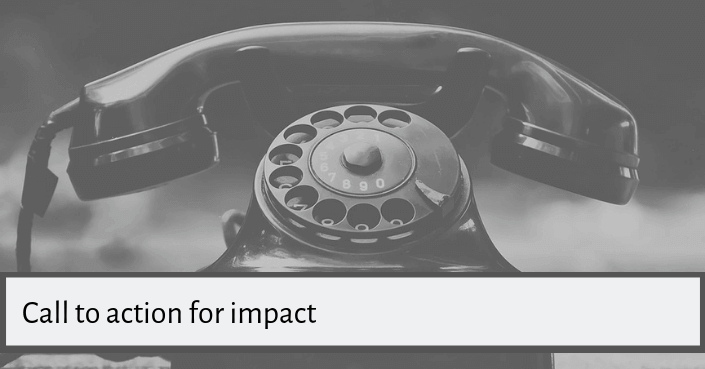
2. Skip the Q&A at the end your presentation
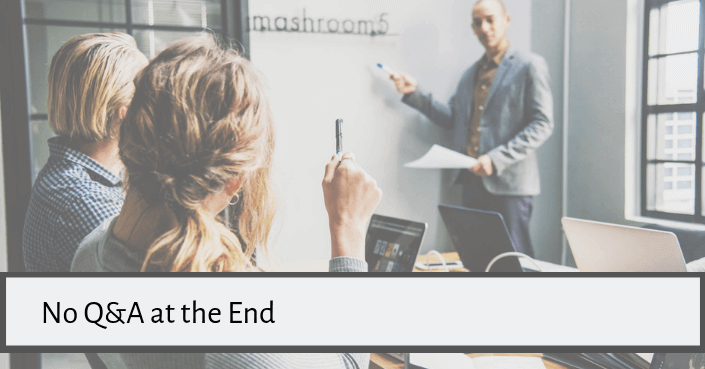
3. End your presentation with a rhetorical Question
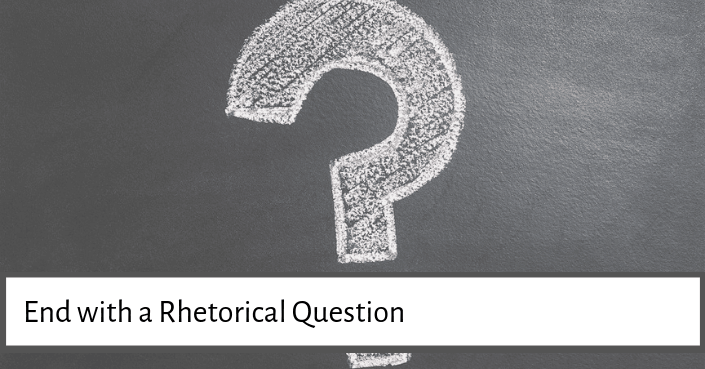
You are currently viewing a placeholder content from Youtube . To access the actual content, click the button below. Please note that doing so will share data with third-party providers.
4. Conclude your speech with a story

As you can learn in our post on the best ways to start a presentation ( details here ), emotional listeners retain more information. An emotional story, whether it’s funny, sad, or thought-provoking, is a sure fire way to engage your audience.
If you can, try to tie the beginning and end together with your stories, like Heather Lanier does here:
You are currently viewing a placeholder content from Default . To access the actual content, click the button below. Please note that doing so will share data with third-party providers.
5. The power of 3 for your conclusion
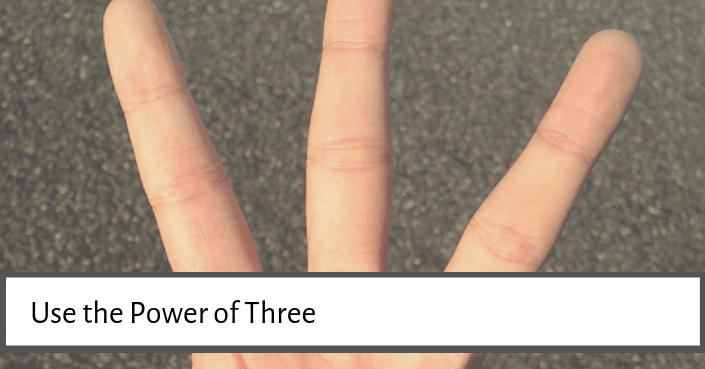
6. Come full circle at the end of your presentation

- Pose a question which you answer at the end
- Tell a story and either refer to it or finish it at the end
- Repeat the first slide, this work especially well with powerful images or quotes
7. Demonstrate your product

8. End with an either / or scenario
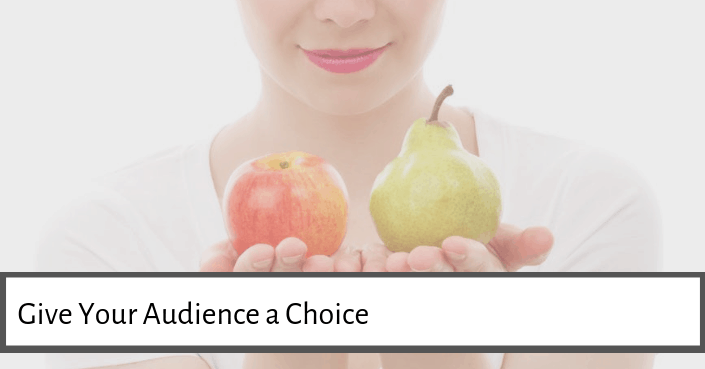
9. End your presentation on a high note

10. A sound bite
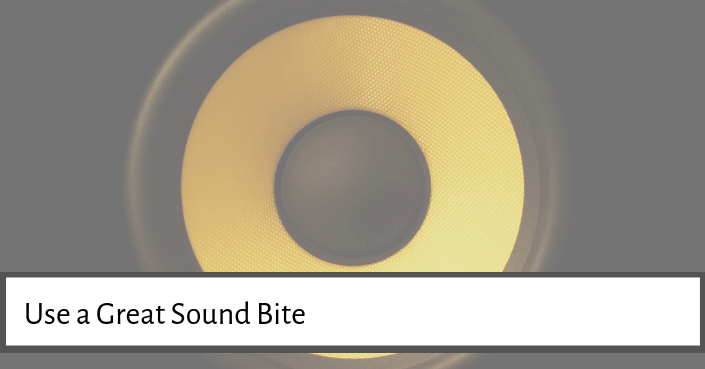
11. End with a provocative question
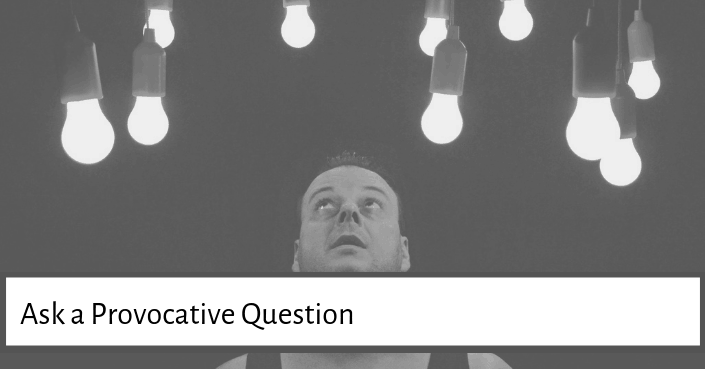
12. Use the title close technique

13. A quick presentation recap

14. End with a powerful quote
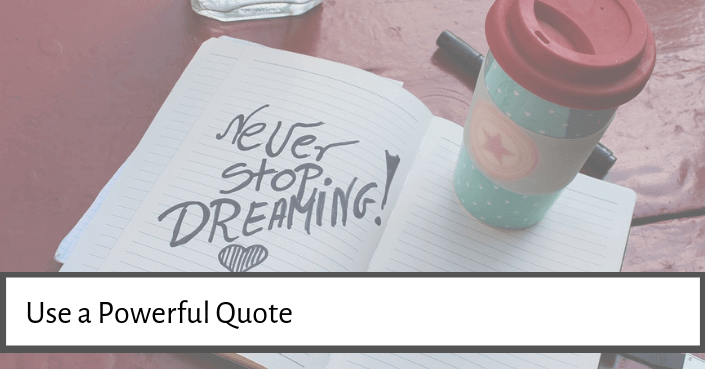
15. End with a strong visual image
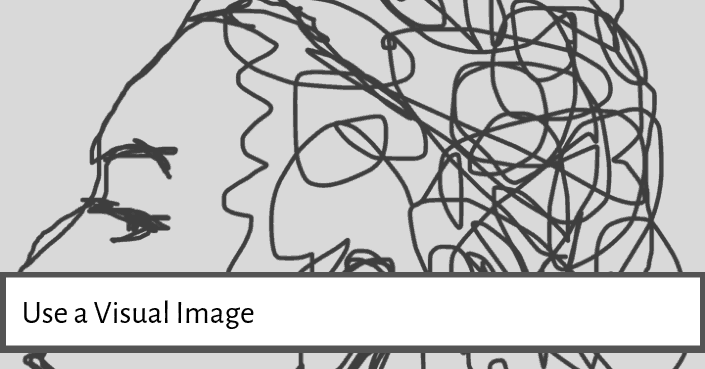
16. Close with a clear cut ending
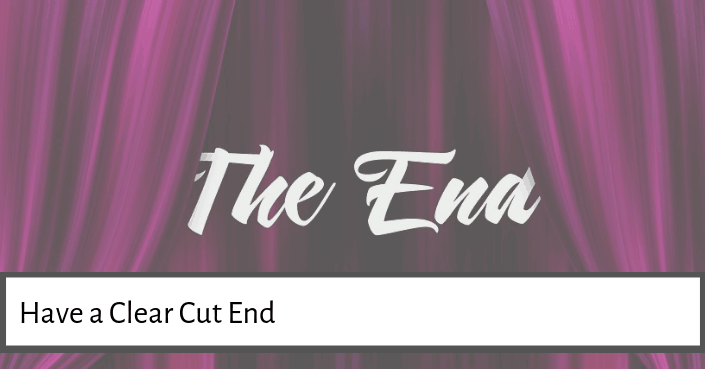
17. End your presentation on time
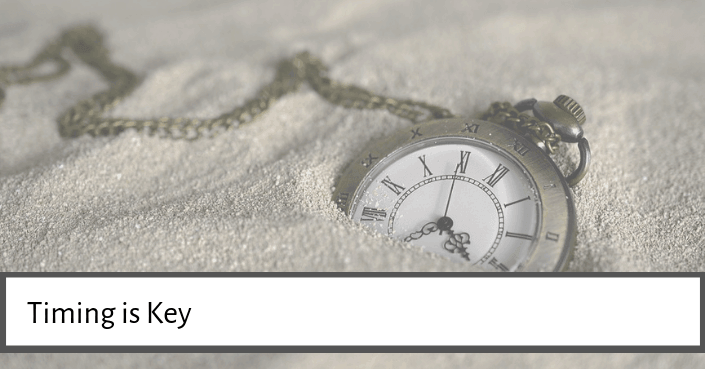
What’s Next?
Related articles, about the author.
Popular Tutorials
- How to Strikethrough Text (l̶i̶k̶e̶ ̶t̶h̶i̶s̶) in Word, Excel & PowerPoint
- How to Make Animated Fireworks in PowerPoint (Step-by-Step)
- Strikethrough Shortcut (l̶i̶k̶e̶ ̶t̶h̶i̶s̶) for Word, Excel & PowerPoint
- How to Create a Flash Card Memory Game in PowerPoint (Like Jeopardy)
- Keyboard Shortcuts Not Working: Solved
PowerPoint Tutorial Categories
- Strategies & Opinions
- Shortcuts & Hacks
- Pictures, Icons, Videos, Etc.
- New Features
- Miscellaneous
- Charts & Data Viz
We help busy professionals save hours and gain peace of mind, with corporate workshops, self-paced courses and tutorials for PowerPoint and Word.
Work With Us
- Corporate Training
- Presentation & Template Design
- Courses & Downloads
- PowerPoint Articles
- Word Articles
- Productivity Resources
Find a Tutorial
- Free Training
- For Businesses
We help busy office workers save hours and gain peace of mind, with tips, training and tutorials for Microsoft PowerPoint and Word.
Master Critical PowerPoint Shortcuts – Secure Your FREE Training Module and Save Valuable Time!
⌛ Master time-saving expert techniques.
🔥 Create powerful presentations.
🚀 Propel your career to new heights.
We value your privacy – we keep your info safe.
Discover PowerPoint Hacks Loved by Industry Giants - KKR, AmEx, HSBC!
Over 114,880 professionals in finance, marketing and sales have revolutionized their PPT skills with our proven methods.
Gain FREE access to a full module of our premium PowerPoint training program – Get started today!
We hate spam too and promise to keep your information safe.
You are currently viewing a placeholder content from Facebook . To access the actual content, click the button below. Please note that doing so will share data with third-party providers.
Home Blog Presentation Ideas Key Insights on How To End a Presentation Effectively
Key Insights on How To End a Presentation Effectively
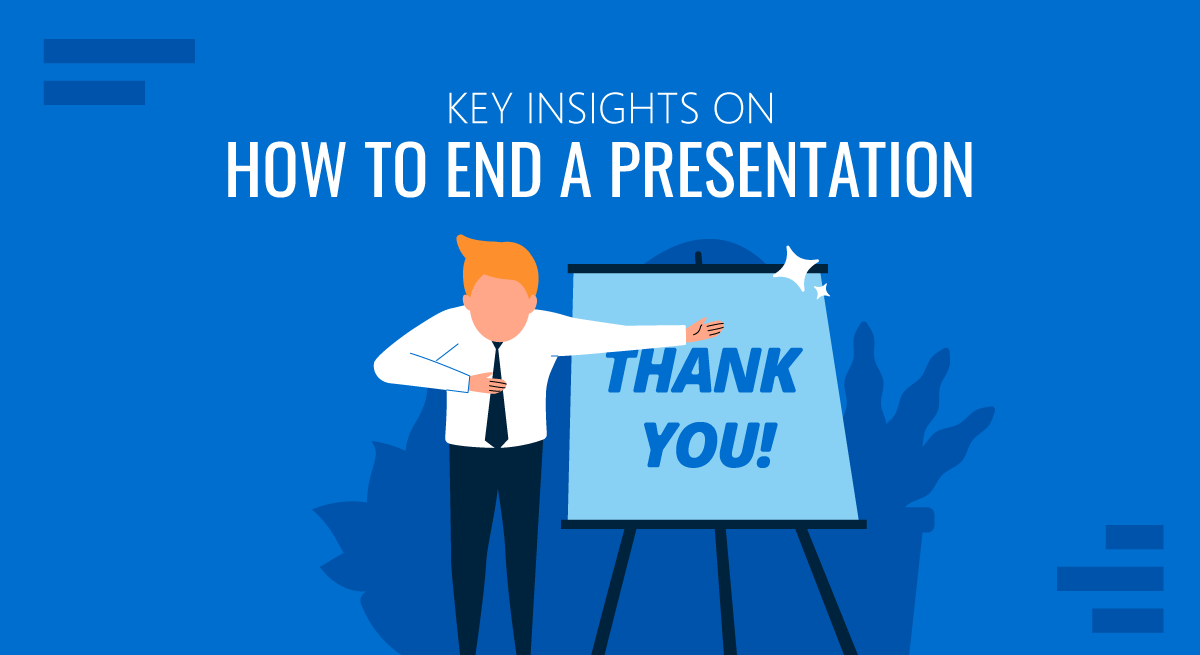
A piece of research by Ipsos Corporate Firm titled “Last Impressions Also Count” argues that “our memories can be governed more by how an experience ends than how it begins .” A lasting final impression can be critical to any presentation, especially as it makes our presentation goals more attainable. We’re covering how to end a presentation , as it can certainly come through as an earned skill or a craft tailored with years of experience. Yet, we can also argue that performing exceptionally in a presentation is conducting the proper research. So, here’s vital information to help out with the task.
This article goes over popular presentation types; it gives suggestions, defines the benefits and examples of different speech closing approaches, and lines all this information up following each presentation purpose.
We also included references to industry leaders towards the end, hoping a few real-life examples can help you gain valuable insight. Learn from noted speakers and consultants as you resort to SlideModel’s latest presentation templates for your efforts. We’re working together on more successful presentation endings that make a difference!
Table of Content
A presentation’s end is not a recap
The benefits of ending a presentation uniquely, the power of closing in persuasive presentations, informative presentations: the kind set out to convey, call to action presentations: trigger actions or kickoff initiatives, a final word on cta presentations, real-life examples of how to end a presentation, succeeding with an effective presentation’s ending.
We need to debunk a widespread myth to start. That’s why the ending of the presentation calls for an appealing action or content beyond just restating information that the speaker already provided.
A presentation’s end is not a summary of data already given to our audience. On the contrary, a wrap-up is a perfect time to provide meaningful and valuable facts that trigger the desired response we seek from our audience. Just as important as knowing how to start a presentation , your skills on how to end a PowerPoint presentation will make a difference in the presentation’s performance.
Effective ways to end a presentation stem from truly seeking to accomplish – and excel – at reaching a presentation’s primary objective. And what are the benefits of that?
Considering the benefits of each closing approach, think about the great satisfaction that comes from giving an excellent presentation that ends well. We all intuitively rejoice in that success, regardless of the kind of audience we face.
That feeling of achievement, when an ending feels right, is not a minor element, and it’s the engine that should drive our best efforts forward. Going for the most recommended way of ending a presentation according to its primary goal and presentation type is one way to ensure we achieve our purpose.
The main benefit of cleverly unlocking the secret to presentation success is getting the ball rolling on what we set ourselves to achieve . Whether that’s securing a funding round, delivering a final project, presenting a quarterly business review, or other goals; there is no possible way in which handling the best presentation-ending approaches fails to add to making a skilled presenter, improving a brand or business, or positively stirring any academic or commercial context.
The best part of mastering these skills is the ability to benefit from all of the above time and time again; for any project, idea, or need moving forward.
How to end a PowerPoint Presentation?
PowerPoint Presentations differ by dimensions. They vary not only tied to the diverse reasons people present, but they also separate themselves from one another according to: a- use, b- context, c- industry, and d- purpose.
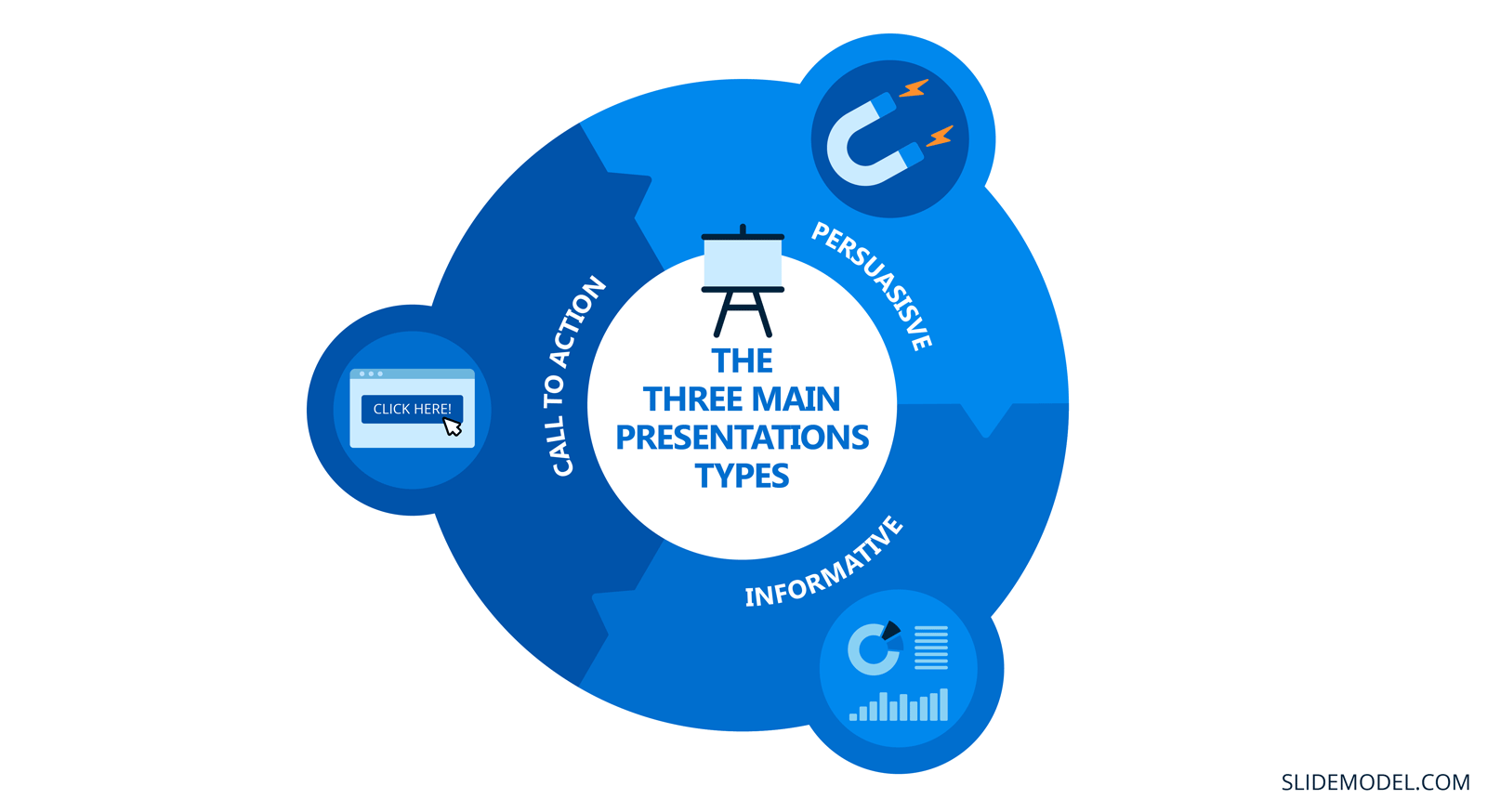
We’re focusing on three different types of presentation pillars, which are:
- Informative
- Calls to action
As you can guess, the speaker’s intent varies throughout these types. Yet, there’s much more to each! Let’s go over each type’s diverse options with examples.
In 2009, “The New Rules of Persuasion,” a journal article published by The Royal Society for Arts, Manufactures, and Commerce, determined that commercial persuasion was missing “the ability to think clearly about behavior goals and the mindset of starting small and growing what works.” Incorporating these thoughts is still equally valid in persuasive presentations today.
What hasn’t changed since, however, is this society’s good reminder that “the potential to persuade is in the hands of millions.” As they stated in that publication, “ordinary people sitting in dorm rooms and garages can compete against the biggest brands and the richest companies.” The proven reality behind that concept can be pretty inspiring.
According to this source, “ the first critical step in designing for persuasion is to select an appropriate target behavior. ” And, for behavior to occur, in their opinion, “three elements must converge at the same moment […]: Motivation , Ability, and Trigger .” This theory signals a person is motivated through sensation, anticipation, or belonging when they can perform a particular action. This concept is at the backbone of setting the correct trigger to allow a group of people to react a certain way.
The above is of utmost importance as we seek to gear persuasive efforts. The more insight we get on the matter, the easier it is to define the precise actions that will effectively trigger a certainly required response – in any scenario.
Here are options on how to deliver a final punch in a persuasive presentation during different types of objectives:
Investment presentations
Whenever you seek funding, that need should be expressly clear during a pitch. Investors need to know what’s in it for them on a given investment. Highlight what interests them, and add what the return for the investor is. Mention dividends, equity, or the return method selected, for instance. Your final ask slide should show the exact amount you’re looking for during this funding stage.
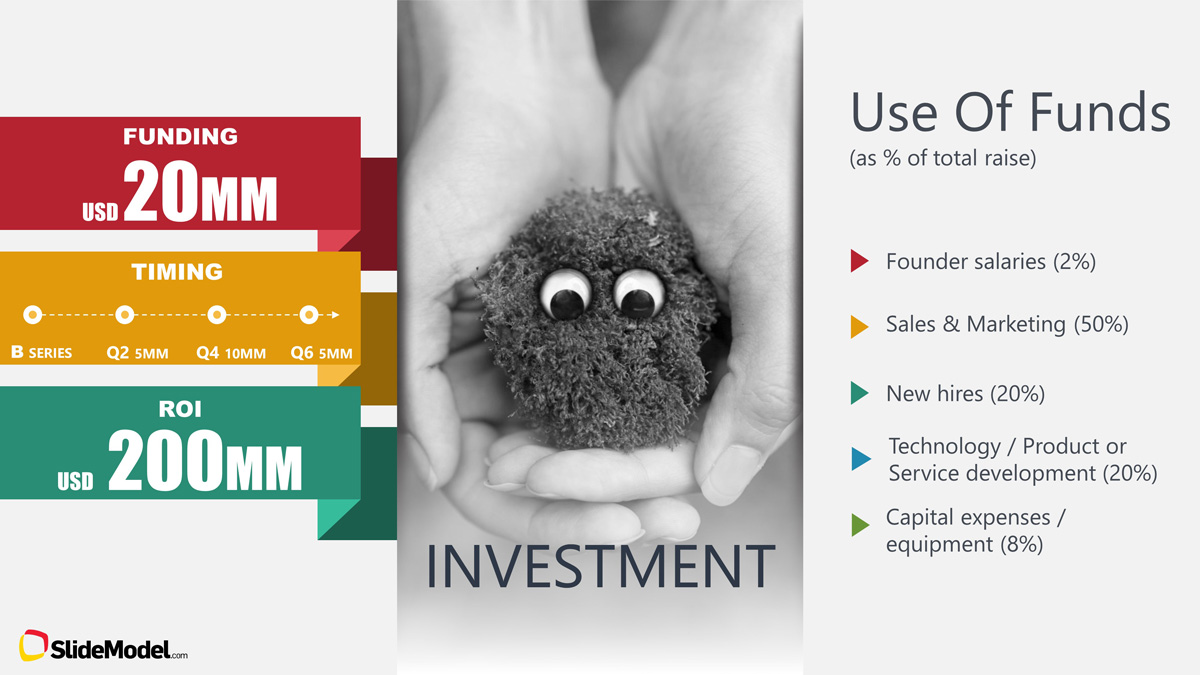
Throughout, explain what an investor’s return on investment (ROI) will be. And make sure you do so according to provable calculations. Here, the goal is to display current figures and future opportunities in your speech.
You mustn’t make up this data. In this setting, presenters are naturally assessed by their ability to stay within real options fully supported by proven and concise reliable information.
Focus on showing an ability to execute and accomplish expected growth. Also, be precise on how you’re using any trusted funds . For that, mention where they’ll be allocated and how you foresee revenue after investing the funds in your idea, product, or company.
Pitch Presentations
Pitches are also another form of persuasive presentation. Presenters are expected to wow in new ways with them, be engaging in their approach, and deliver valuable, market-impacting data. When someone delivers a pitch, it seeks a particular kind of action in return from the audience. Being fully engaged towards a presentation’s end is crucial.
Make sure you give the presentation’s end a Call to Action slide in sales. You’re certainly looking to maximize conversion rates here. Bluntly invite your audience to purchase the product or service you’re selling, and doing so is fair in this context. For example, you can add a QR code or even include an old-fashioned Contact Us button. To generate the QR code, you can use a QR code generator .

According to Sage Publishing , there are “four types of informative speeches[, which] are definition speeches, demonstration speeches, explanatory speeches, and descriptive speeches.” In business, descriptive speeches are the most common. When we transport these more specifically to the art of presenting, we can think of project presentations, quarterly business reviews, and product launches. In education, the definition and demonstration speeches are the norm, we can think in lectures and research presentations respectively.
As their name suggests, these presentations are meant to inform our audiences of specific content. Or, as SAGE Flex for Public Speaking puts it in a document about these kinds of speeches, “the speaker’s general goal is always to inform—or teach—the audience by offering interesting information about a topic in a way that helps the audience remember what they’ve heard.” Remember that as much as possible, you’re looking to, in Sage’s words, give out “information about a topic in a way that’s easy to understand and memorable.” Let’s see how we manage that in the most common informative presentation scenarios mentioned above.
Project Presentations
For projects, presentations should end with an action plan . Ensure the project can keep moving forward after the presentation. The best with these conclusion slides is to define who is responsible for which tasks and the expected date of completion. Aim to do so clearly, so that there are no remaining doubts about stakeholders and duties when the presentation ends. In other words, seek commitment from the team, before stepping out of these meetings. It should be clear to your audience what’s expected next of them.
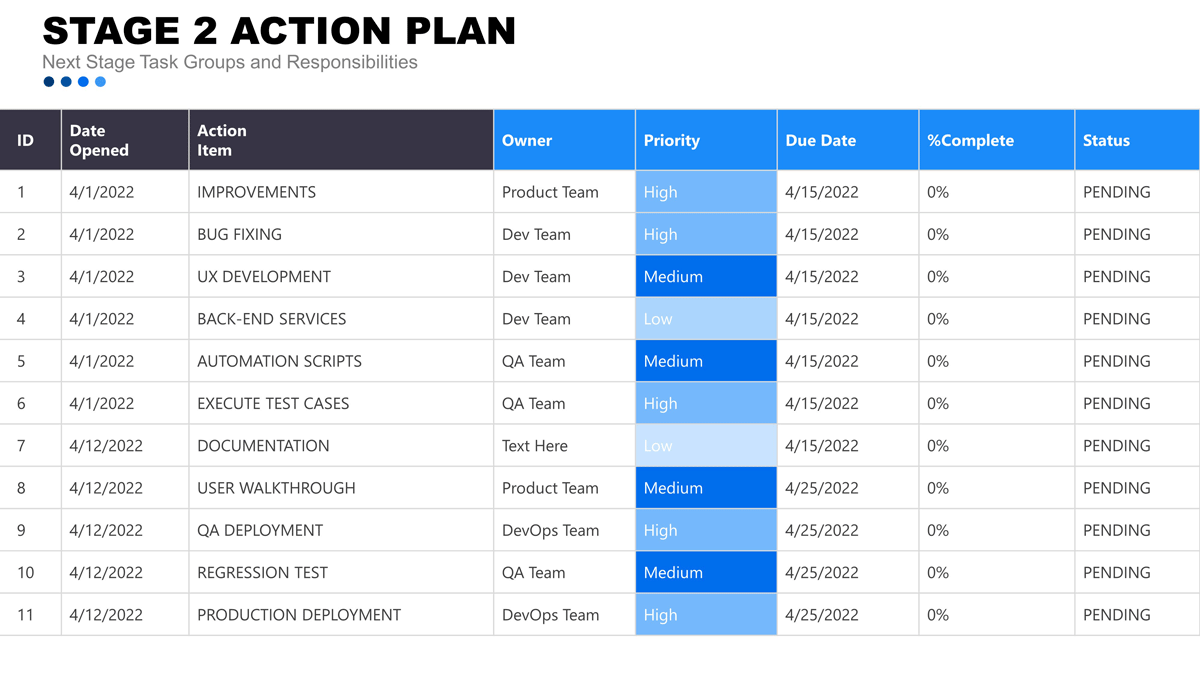
As an addition, sum up, your problem, solution, and benefits of this project as part of your final message.
Quarterly Business Review Presentations (QBR)
By the end of the presentation type, you would’ve naturally gone over everything that happened during a specific quarter. Therefore, make sure you end this quarterly review with clear objectives on what’s to come for the following term. Be specific on what’s to come.
In doing so, set figures you hope to reach. Give out numbers and be precise in this practice. Having a clear action plan to address new or continuing goals is crucial in this aspect for a recent quarter’s start out of your QBR. Otherwise, we’re missing out on a true QBR’s purpose. According to Gainsight , “If you go into a QBR without a concrete set of goals and a pathway to achieve them, you’ll only waste everyone’s time. You won’t improve the value of your product or services for your customers. You won’t bolster your company’s image in the eyes of key stakeholders and decision-makers. You won’t better understand your client’s business objectives.” As they put it, “Lock in solid goals for the next quarter (or until your next QBR)” and secure your way forward as the last step in presenting these kinds of data. Visit our guide on How to Write an Effective Quarterly Business Review for further tips on this type of presentation.

Research presentations
Your research has come this far! It’s time to close it off with an executive summary.
Include the hypothesis, thesis, and conclusion towards the presentation’s end.
How do you get the audience to recall the main points of all this work? Let this guiding question answer what to insert in your final slide, but seek to reinforce your main findings, key concepts, or valuable insight as much as possible. Support your statements where necessary.
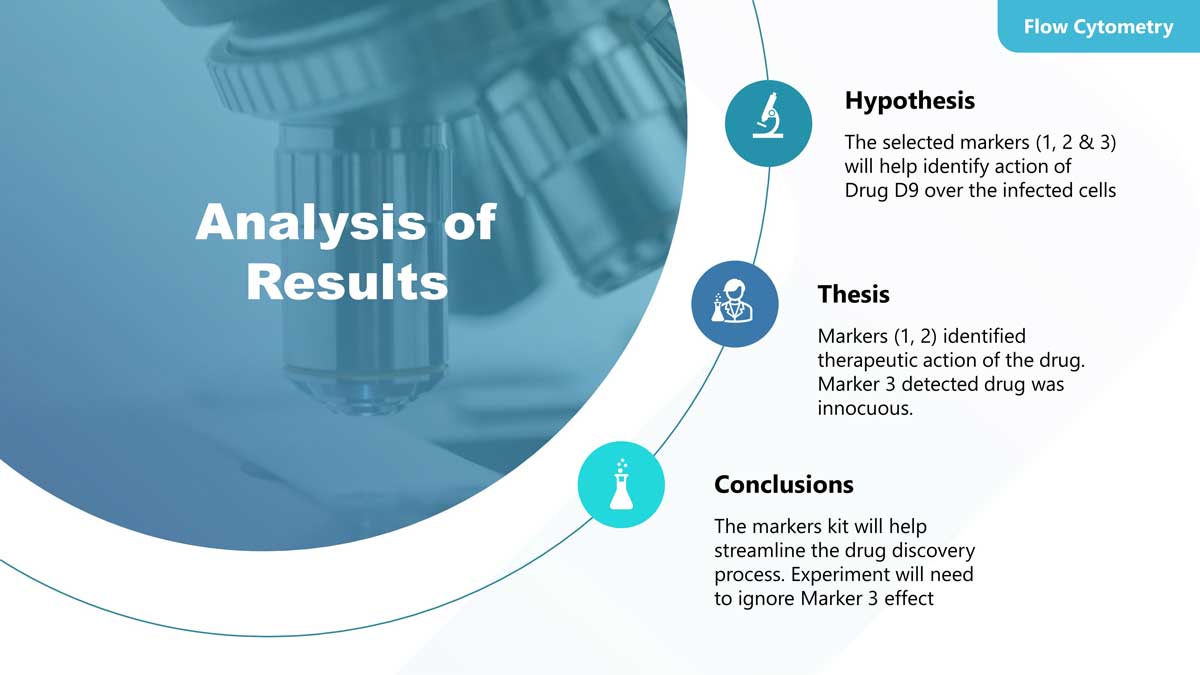
Most commonly, researchers end with credits to the collaborating teams. Consider your main messages for the audience to take home. And tie those with the hypothesis as much as possible.
Product Launch Presentation
Quite simply, please take out the product launch’s roadmap and make it visible for your presentation’s end in this case.
It’s ideal for product launch presentations to stir conversations that get a product moving. Please don’t stick to showcasing the product, but build a narrative around it.

Steve Jobs’ example at the bottom might help guide you with ideas on how to go around this. A key factor is how Apple presentations were based on a precise mix of cutting-edge, revolutionary means of working with technology advancements and a simple human touch.
Elon Musk’s principles are similar. People’s ambitions and dreams are a natural part of that final invitation for consumers or viewers to take action. What will get your audience talking? Seek to make them react.
Lecture for specific classes / educational presentation
When it comes to academic settings, it’s helpful to summarize key points of a presentation while leaving room for questions and answers.
If you’re facing a periodic encounter in a class environment, let students know what’s coming for the next term. For instance, you could title that section “What’s coming next class,” or be creative about how you call for your student body’s attention every time you go over pending items.
If you need to leave homework, list what tasks need to be completed by the audience for the next class.
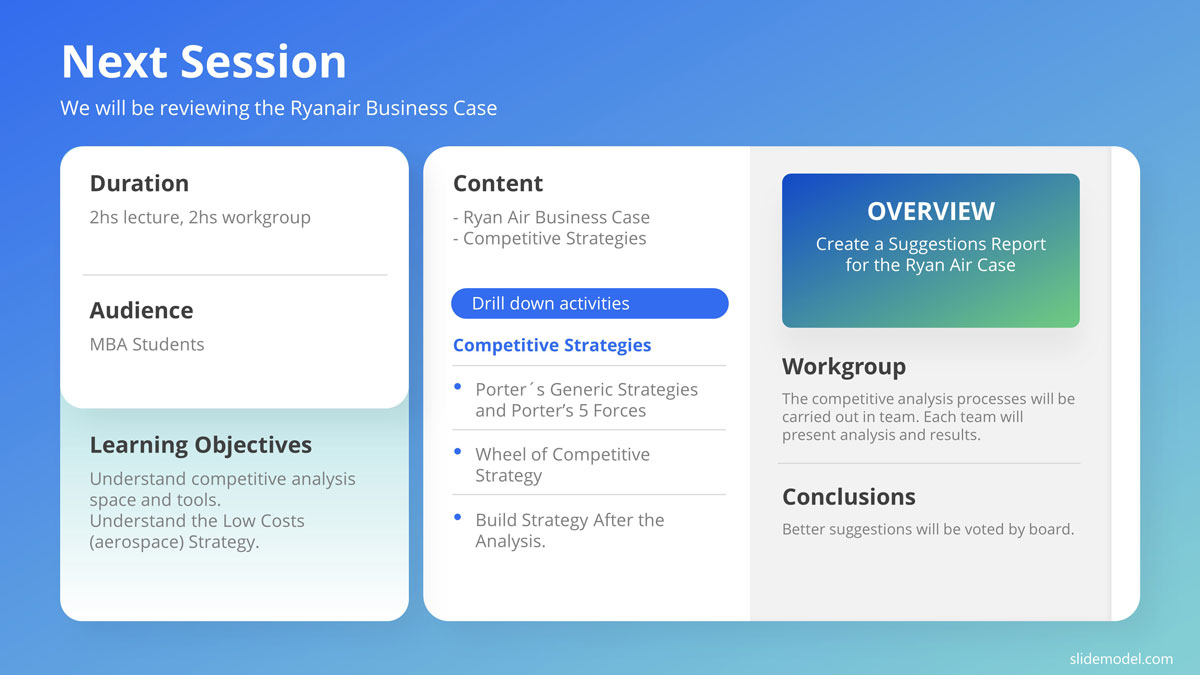
Another option is to jot down the main learnings from this session or inspire students to come back for the following class with a list of exciting topics. There’s more room for play in this setting than in the others we’ve described thus far.
Harvard Business Review (HBR) concisely describes the need at the end of a call to action presentation. HBR’s direct piece of advice is that you should “use the last few moments of your presentation to clarify what action [an audience] can take to show their support.” And what’s key to HBR is that you “Also mention your timeframe” as, for them, “a deadline can help to urge [the audience] into action.” Having a clear view of specific timelines is always fruitful for a better grasp of action items.
In her book Resonate, Nancy Duarte explains that “No matter how engaging your presentation may be, no audience will act unless you describe a reward that makes it worthwhile. You must clearly articulate the ultimate gain for the audience […] If your call to action asks them to sacrifice their time, money, or ideals, you must be very clear about the payoff.”
Business plan presentations
Here, we need to speak of two different presentation types, one is a traditional approach , and the second is what we call a lean approach .
For the traditional business plan presentation, display each internal area call to action. Think of Marketing, Operations, HR, and even budgets as you do so. Your PowerPoint end slide should include the rewards for each of the areas. For example, which will benefit each area when achieving the targets, or how will the company reward its employees when attaining specific goals? Communicating the reward will help each of the responsible entities to trigger action.
On the other hand, for your lean business plan, consider a business model canvas to bring your presentation to an end.
Job interview presentations
You can undoubtedly feel tons of pressure asking for a specific position. For a great chance of getting that new job, consider closing your case with a 30 60 90 day plan as a particular hiring date. The employer will see its reward in each of the 30-day milestones.
Also, show off what you’ll bring to the role and how you’ll benefit the company in that period, specifically. Again, to a certain extent, we’re seeking to impress by being offered a position. Your differentiator can help as a wrap-up statement in this case.
Business Model Presentation
The pivot business model fits perfectly here for a presentation’s grand finale. The reward is simple; the business validated a hypothesis, and a new approach has been defined.
Though the setting can be stressful around business model presentations, you can see this as simply letting executives know what the following line of steps will need to be for the business model to be scalable and viable. Take some tension off this purpose by focusing on actions needed moving forward.
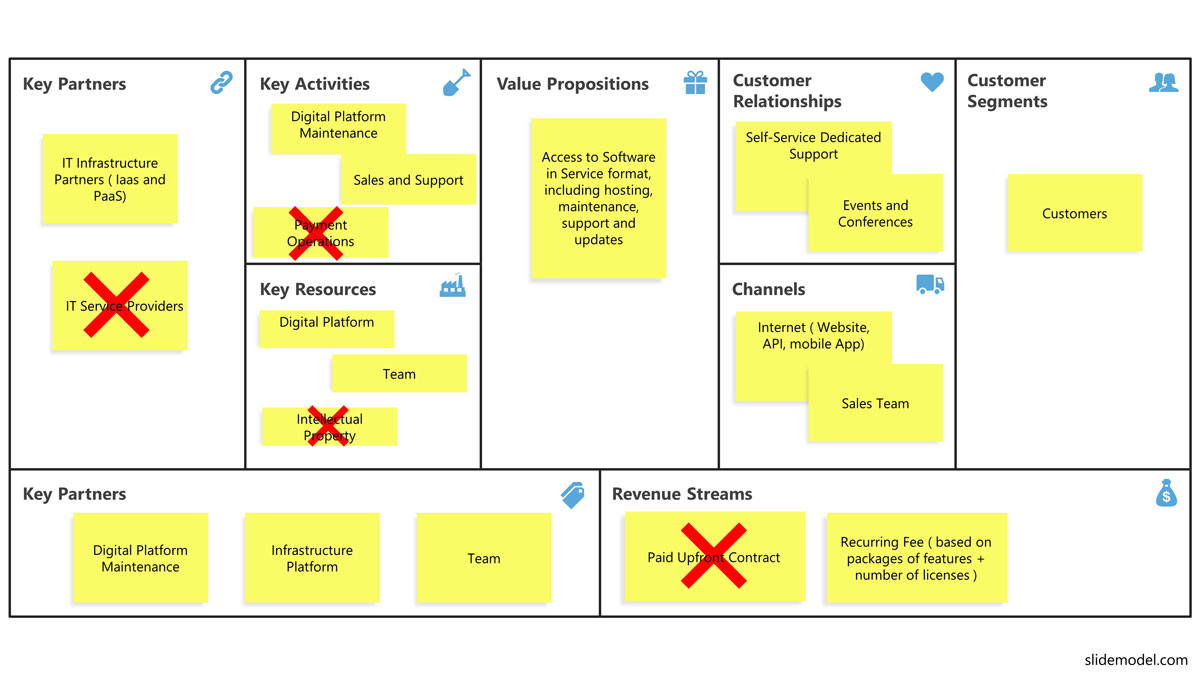
Your call to action will center around a clear business model canvas pivot here.
We need to work hard at ending presentations with clear and concise calls to action (CTA) and dare be creative as we’re doing so! Suppose you can manage to give out a specific CTA in a way that’s imaginative, appealing, and even innovative. In that case, you’ll be showing off priceless and unique creative skills that get people talking for years!
Think of Bill Gates’ releasing mosquitoes in a TED Talk on malaria, for example. He went that far to get his CTA across. Maybe that’s a bit too bold, but there’s also no limit!
Now that we can rely on a broader understanding of how to conclude a presentation successfully, we’ll top this summary off with real-life examples of great endings to famous speakers’ presentations. These people have done a stellar job at ending their presentations in every case.
We’re also going back to our three main pillars to focus on a practical example for each. You’ll find an excellent example for an informative speech, a persuasive pitch, and a successful investor pitch deck. We’re also expanding on the last item for a guiding idea on ending a pitch directly from Reid Hoffman.
Informational Presentation: A product launch of a phone reinvention
The first is what’s been titled “the best product launch ever.” We’re going back to the iconic Steve Jobs’ iPhone launch dated more than a decade ago. You can see how to end a presentation with a quote in this example effectively. The quote resonates with the whole presentation purpose, which was not “selling” the iPhone as a “hardware phone” but as the “hardware” platform for “great software.” Closing with a quote from a famous personality that summarizes the idea was a clever move.
Little words are needed to introduce Steve Jobs as a great speaker who effectively moved the business forward every time he went up on a stage to present a new product. No one has ever been so revolutionary with a calm business spirit that has changed the world!
Persuasive Presentation: The best pitch deck ever
We’re giving you the perfect example of a great pitch deck for a persuasive kind of presentation.
Here’s TechCrunch’s gallery on Uber’s first pitch deck .
As you can see, the last slide doesn’t just report the status to date on their services; it also accounts for the following steps moving forward with a precise date scheduled.
Check the deck out for a clearer idea of wrapping up a persuasive business presentation.
Call to Action Presentation: LinkedIn’s Series B pitch deck by Reid Hoffman
As mentioned before, here’s an expanded final sendoff! Reid Hoffman is an established entrepreneur. As a venture capitalist and author, he’s earned quite a remarkable record in his career, acting as co-founder and executive chairman of LinkedIn.
We’re highlighting LinkedIn’s series B pitch deck to Greylock Partners mainly because these slides managed to raise a $10 M funding round. Yet, moreover, we’re doing so because this deck is known to be well-rounded and overall highly successful.
LinkedIn may be famous now for what it does, but back in 2004, when this deck made a difference, the company wasn’t a leader in a market with lots of attention. As Reid highlights on his website, they had no substantial organic growth or revenue. Yet, they still managed to raise a considerable amount.
In Reid’s words for his last slide, “The reason we reused this slide from the beginning of the presentation was to indicate the end of presentation while returning to the high line of conceptualizing the business and reminding investors of the value proposition.” In his vision, “You should end on a slide that you want people to be paying attention to,” which he has tied with the recommendation that you “close with your investment thesis,” as well. A final note from him on this last slide of LinkedIn’s winning pitch is that “the end is when you should return to the most fundamental topic to discuss with your investors.” Quite a wrap-up from a stellar VC! Follow the linked site above to read more on the rest of his ending slides if you haven’t ever done so already.
The suggestions above are practical and proven ways to end a presentation effectively. Yet, remember, the real secret is knowing your audience so well you’ll learn how to grasp their attention for your production in the first place.
Focus on the bigger picture and add content to your conclusion slide that’s cohesive to your entire presentation. And then aim to make a lasting final impression that will secure what you need. There is a myriad of ways to achieve that and seek the perfect-suiting one.
Also, be bold if the area calls for it. As you see above, there is no shame, but an actual need to state the precise funding amount you need to make it through a specific stage of funding. Exercise whatever tools you have at your disposal to get the required attention.
Also, being sure about whatever decision you make will only make this an easier road to travel. If your head is transparent about what’s needed, you’ll be more confident to make a convincing case that points your audience in the right direction.
Check out our step-by-step guide on how to make a presentation .

Like this article? Please share
Business, Business Development, Business PowerPoint Templates, Business Presentations, Corporate Presentations, PowerPoint Tips, Presentation Approaches Filed under Presentation Ideas
Related Articles

Filed under Business • May 17th, 2024
How to Make a Transition Plan Presentation
Make change procedures in your company a successful experience by implementing transition plan presentations. A detailed guide with PPT templates.

Filed under Business • April 22nd, 2024
Setting SMART Goals – A Complete Guide (with Examples + Free Templates)
This guide on SMART goals introduces the concept, explains the definition and its meaning, along the main benefits of using the criteria for a business.

Filed under Design • March 27th, 2024
How to Make a Presentation Graph
Detailed step-by-step instructions to master the art of how to make a presentation graph in PowerPoint and Google Slides. Check it out!
Leave a Reply

- Video Marketing
- Case Studies
- Create a video

How to End a Presentation? [Top 8 Strategies with Examples]
Guru - May 9, 2023 - Leave your thoughts. 9 min read
animaker deck , presentation , presentation ideas , Presentation Software , presentation tips
How you end a presentation is just as crucial as its opening. It can make or break the impression that you leave on your audience.
A strong conclusion can reinforce your key message and ensure that your audience remembers it even after the presentation is over.
A well-concluded presentation can leave your audience impressed, energized, and motivated to take action.
So now, are you wondering what’s the best way to conclude your presentation? Don’t worry! You have come to the right place!
To help you make a powerful ending to your presentation, we have compiled a list of 8 different strategies in this blog post.
Each of these strategies is designed to help you create a memorable and impactful conclusion to your presentation.
By choosing the most appropriate one for your presentation, you can ensure that your audience remembers your key message and feels motivated to take action.
Let’s jump right in,
1. Emphasize the core message 2. Mirror your opening statement 3. Pose an open-ended question 4. End with a Call to action 5. Thank the audience 6. End with a powerful quote 7. Acknowledge your contributors 8. Ask for feedback
1. Emphasize the core message:
One of the most important aspects of any presentation is ensuring your audience understands your core message.
Reiterating your main points and summarizing your message at the end of your presentation can reinforce this and leave a lasting impression.
It helps to ensure that your audience understands the purpose of your presentation and has a clear takeaway from the information you have provided.
In this video, the speaker restates her topic to conclude her speech firmly and gives a pause, resulting in tremendous applause from the audience.
Similarly, by restating your core message, you can also create a sense of cohesion and give your presentation a firm closure.
This can be particularly important if you want to motivate your audience to take action or influence their behavior in some way.
However, it's important not to repeat EVERYTHING you have said. Instead, focus on the most crucial elements and highlight them in a concise and clear manner.
2. Mirror your opening statement:
A great way to end your presentation is by mirroring your opening statement in your conclusion.
Highlighting your presentation's key message at the end and emphasizing the central idea you aimed to communicate will help your audience to retain it in their memory.
During the conclusion of the presentation, the speaker effectively utilized the technique of mirroring the opening example she had presented - ordering a pizza on the phone by herself.
The speaker demonstrated the remarkable transformation she had undergone in terms of personal growth and confidence, which strongly reinforced her message to the audience.
By mirroring her opening example, she created a sense of familiarity and connection with her audience while simultaneously driving home the key message of her presentation.
This technique allowed the audience to understand better and relate to the speaker's personal journey and the message she was conveying.
Similarly, you can also use this strategy to conclude your presentation. This can be particularly effective if you are trying to reinforce a specific theme or idea throughout your presentation.
3. Pose an open-ended question:
One of the best ways to conclude your presentation is to elicit a response from your audience using an open-ended question that can effectively engage them and make your presentation more memorable.
Look at how the speaker concludes her speech with an open-ended question in this video.
Similarly, you can also raise open-ended questions to help your audience look from a different perspective and encourage them to investigate more thoroughly on the information presented.
Most importantly, ensuring that your question is relevant to your presentation and doesn't detract from your overall message is essential when eliciting a response.
So make sure that you kindle your audiences’ thoughts and ideas with the open-ended question at the end. This helps create a good long-lasting impression of your presentation.
4. End with a Call to action:
One of the best ways to end your presentation is by concluding with a call to action slide.
Incorporating a call to action into your presentation can be a powerful way to encourage your audience to take the next step.
Whether it's signing up for a program, making a purchase, or supporting a cause, a clear call to action is essential to achieving your desired outcome.
Similarly, according to your type of presentation, you can include a relevant call to action.
For example, this might involve providing specific instructions or offering an incentive for taking action, such as a discount or free trial.
It's essential that you understand their pain points and make your call to action compelling. Ensure that your core message and the needs of your audience are aligned so that they are motivated enough to act.
5. Thank the audience:
At the end of your presentation, it's essential to recognize that your audience has taken time out of their busy schedules to attend and listen to your message.
Thanking your audience for their time and attention can create a positive impression and make them feel appreciated.
It's essential to make your gratitude genuine and sincere rather than a superficial gesture. For example, consider expressing your gratitude with a personal anecdote or acknowledging specific individuals in the audience.
This simple act of gratitude can also create a sense of personal connection and signal to your audience that the presentation has reached its conclusion, paving the way for future interactions with them.
6. End with a powerful quote:
One effective strategy to end your presentation on a high note is by leaving the audience with a powerful quote.
However, it's crucial to choose a quote that is not only impactful but also unique and relevant to your topic.
Using a commonly known quote may come across as unoriginal and irrelevant, losing the attention and interest of your audience in most cases.
In this presentation, Steve Jobs concludes his speech with an inspiring and powerful message, “Stay Hungry! Stay Foolish”. Thereby emphasizing that you should never stop learning, pursue more goals, and never stop being satisfied.
Similarly, in your conclusion, consider using a relevant quote to make an impact.
7. Acknowledge your contributors:
Another best way to conclude your presentation is by showing gratitude to your contributors.
For example, if you deliver a business presentation on behalf of a team or a department, it's essential to recognize the collective effort that went into creating the presentation.
The concluding moments of your speech are the perfect opportunity to acknowledge your team members' hard work and dedication.
You can express gratitude to your team as a whole, thanking them for their contribution to the presentation.
However, if you want to ensure that the individual efforts of team members are recognized, highlighting specific contributions may be a better approach.
Some examples include:
"Join me in giving a round of applause to my incredible team, who played a significant role in arranging this pitch deck."
"Finally, I would like to mention that my tech team experts provided me with insight into the technical nuances, and without their contribution, this presentation would not have been as informative as it is now."
"As I conclude, I want to express my gratitude to Mark and Serene from the Marketing team, whose assistance in gathering the data and designing the slides was invaluable."
By acknowledging individual team members, you are demonstrating your appreciation for their work and giving them the recognition they deserve.
This will not only make them feel valued but also motivate them to continue contributing to the success of future presentations.
So be sure to end your presentation with the required acknowledgment for all the contributions.
8. Ask for feedback:
You can conclude your presentation seamlessly by thanking the audience and asking for feedback from them.
Encouraging feedback from your audience can greatly benefit your future presentations. It allows you to understand how your message was received and how you can improve for the next time.
So, how can you gather feedback effectively?
Firstly, ask attendees to share their thoughts on your presentation after you finish speaking. This can be done by initiating a Q&A session or by approaching individuals directly.
Another option is to set up a QR code near the exit and ask people to scan and jot down their thoughts on the online form as they leave. This allows attendees to provide their feedback in a confidential and hassle-free manner.
Also, consider having a suggestion box for handwritten feedback notes or creating an anonymous online survey that links to your presentation slides. This method is beneficial if you want to gather feedback from a large audience or if you prefer to have quantitative data.
By actively seeking feedback, you show your audience that you value their input and are committed to improving your presentation skills.
However, this strategy does not apply to all the general presentations. So use this way of concluding your presentation where it makes more sense to you and the audience.
In summary, an impactful conclusion is vital to wrap up your presentation successfully.
Each of these strategies serves a unique purpose, and by combining them, you can create a conclusion that is both engaging and impactful.
By incorporating the 8 critical strategies mentioned in this guide, you can leave a lasting impression on your audience, ensuring that your message stays with them even after the presentation has ended.
Now that you have learned the pro strategies of how to end a presentation, take a look at this guide on “How to start a presentation” as well and nail your presentation from start to end!
If you are still uncertain about how to make a presentation from the ground up, we suggest checking out Animaker Deck - the world's first avatar-driven presentation software.
With over 40 distinct and creatively designed templates at your disposal, we are confident you will find it worth trying!
We hope this article was helpful. Do let us know your thoughts on which strategy worked best for you, and also suggest your own ways of ending a presentation.
Related Posts

How to Embed a Video in Powerpoint? [Supercharge your PPTs Now]

Top 10 Presentation Software for 2023

25 Best Presentation Templates for the Perfect Pitch [For 2023]
Subscribe to get awesome DIY tips that could break the boundaries of other DIY tools.
Create Engaging Animated Videos On Your Own
Our drag-and-drop builder makes it easy for anyone to create pro-level animated videos using pre-made templates and ready-to-go assets with zero technical skills.

- By Illiya Vjestica
- - January 23, 2023
10 Powerful Examples of How to End a Presentation
Here are 10 powerful examples of how to end a presentation that does not end with a thank you slide.
How many presentations have you seen that end with “Thank you for listening” or “Any questions?” I bet it’s a lot…
“Thank you for listening.” is the most common example. Unfortunately, when it comes to closing out your slides ending with “thank you” is the norm. We can create a better presentation ending by following these simple examples.
The two most essential slides of your deck are the ending and intro. An excellent presentation ending is critical to helping the audience to the next step or following a specific call to action.
There are many ways you can increase your presentation retention rate . The most critical steps are having a solid call to action at the end of your presentation and a powerful hook that draws your audience in.
What Action do You Want Your Audience to Take?
Before designing your presentation, start with this question – what message or action will you leave your audience with?
Are you looking to persuade, inspire, entertain or inform your audience? You can choose one or multiple words to describe the intent of your presentation.
Think about the action words that best describe your presentation ending – what do you want them to do? Inspire, book, learn, understand, engage, donate, buy, book or schedule. These are a few examples.
If the goal of your presentation is to inspire, why not end with a powerful and inspiring quote ? Let words of wisdom be the spark that ignites an action within your audience.
Here are three ways to end your presentation:
- Call to Action – getting the audience to take a specific action or next step, for example, booking a call, signing up for an event or donating to your cause.
- Persuade – persuading your audience to think differently, try something new, undertake a challenge or join your movement or community.
- Summarise – A summary of the key points and information you want the audience to remember. If you decide to summarise your talk at the end, keep it to no more than three main points.
10 Examples of How to End a Presentation
1. Asking your audience to take action or make a pledge.

Here were asking the audience to take action by using the wording “take action” in our copy. This call to action is a pledge to donate. A clear message like this can be helpful for charities and non-profits looking to raise funding for their campaign or cause.
2. Encourage your audience to take a specific action, e.g. joining your cause or community

Here was are asking the audience to join our community and help solve a problem by becoming part of the solution. It’s a simple call to action. You can pass the touch to your audience and ask them to take the next lead.
3. Highlight the critical points for your audience to remember.

Rember, to summarise your presentation into no more than three key points. This is important because the human brain struggles to remember more than three pieces of information simultaneously. We call this the “Rule of Three”.
4. If you are trying to get more leads or sales end with a call to action to book a demo or schedule a call.

Can you inspire your audience to sign up for a demo or trial of your product? Structure your talk to lead your prospect through a journey of the results you generate for other clients. At the end of your deck, finish with a specific call to action, such as “Want similar results to X?”
Make sure you design a button, or graphic your prospect can click on when you send them the PDF version of the slides.
5. Challenge your audience to think differently or take action, e.g. what impact could they make?

6. Give your audience actions to help share your message.

7. Promote your upcoming events or workshops

8. Asking your audience to become a volunteer.

9. Direct your audience to learn more about your website.

10. If you are a book author, encourage your audience to engage with your book.


6 Questions to Generate an Ending for Your Presentation
You’ve told an engaging story, but why end your presentation without leaving your audience a clear message or call to action?
Here are six great questions you can ask yourself to generate an ending for your presentation or keynote talk.
- What impression would you want to leave your audience with?
- What is the big idea you want to leave them with?
- What action should they take next?
- What key point should you remember 72 hours after your presentation?
- What do you want them to feel?
- What is the key takeaway for them to understand?
What to Say After Ending a Presentation?
When you get to the end of a book, you don’t see the author say, “thank you for reading my last chapter.” Of course, there is no harm in thanking the audience after your presentation ends, but don’t make that the last words you speak.
Think of the ending of the presentation as the final chapter of an epic novel. It’s your chance to leave a lasting impression on the audience. Close with an impactful ending and leave them feeling empowered, invigorated and engaged.
- Leave a lasting impression.
- Think of it as the last chapter of a book.
- Conclude with a thought or question.
- Leave the audience with a specific action or next step.
How to End a Presentation with Style?
There are many great ways you can end your presentation with style. Are you ready to drop the mic?
Ensure your closing slide is punchy, has a clear headline, or uses a thought-provoking image.
Think about colours. You want to capture the audience’s attention before closing the presentation. Make sure the fonts you choose are clear and easy to read.
Do you need to consider adding a link? If you add links to your social media accounts, use icons and buttons to make them easy to see. Add a link to each button or icon. By doing this, if you send the PDF slides to people, they can follow the links to your various accounts.
What Should you Remember?
💡 If you take one thing away from this post, it’s to lose the traditional ending slides. Let’s move on from the “Thank you for your attention.” or “Any questions.” slides.
These don’t help you or the audience. Respect them and think about what they should do next. You may be interested to learn 3 Tactics to Free Your Presentation Style to help you connect to your audience.
Illiya Vjestica
Share this post:, leave a comment cancel reply.
Your email address will not be published. Required fields are marked *
How to Open and Close a Presentation in 8 Memorable Ways
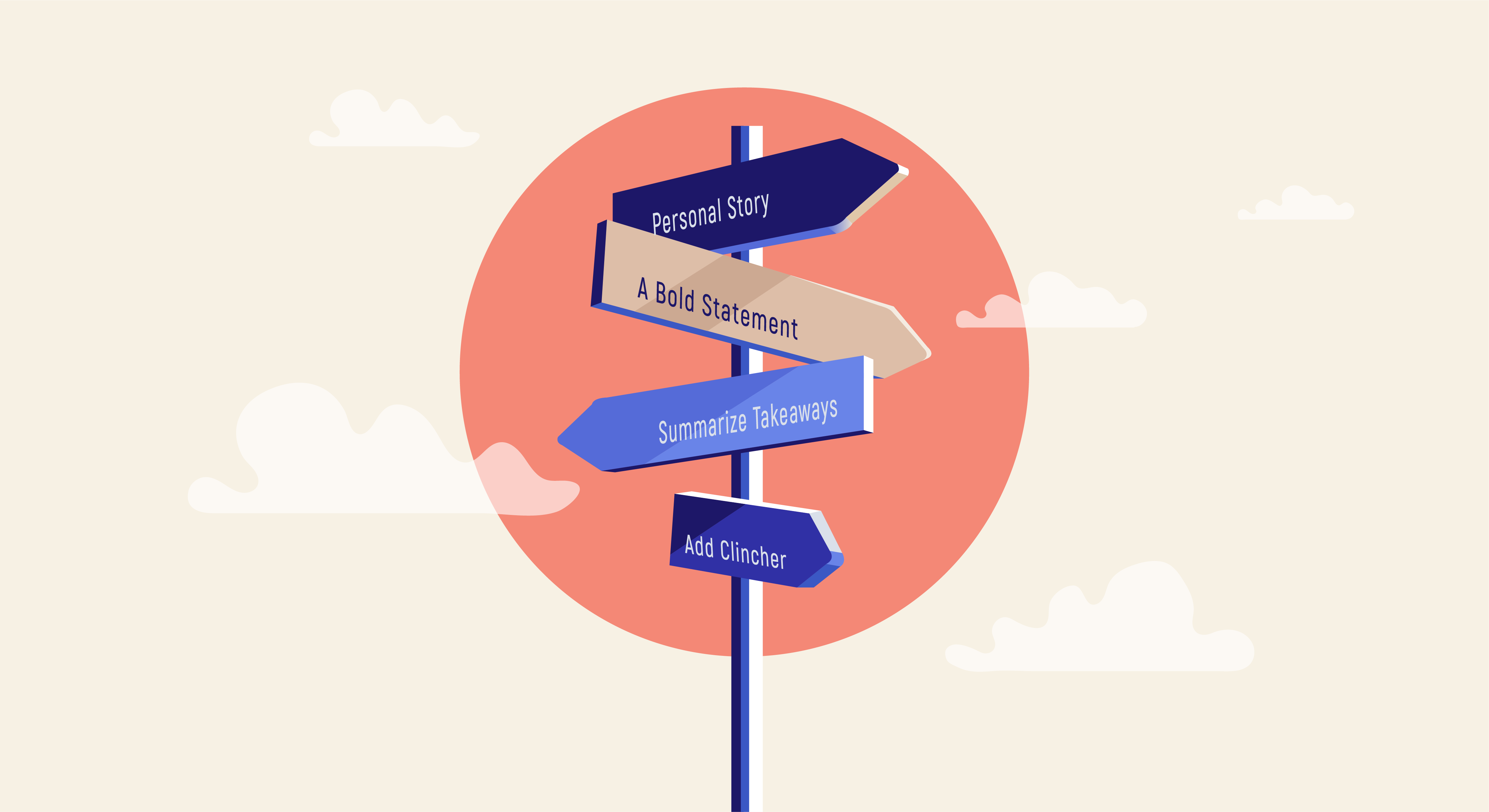
What makes an exceptional presentation? Obviously, it needs to provide plenty of data to support the presenter’s primary objective. But, believe it or not, the heart of a presentation— the gist, the meat, the essence of it— isn’t what makes audiences sit up and take notice.
It doesn’t matter how flashy or informative a presentation (even one designed with a PowerPoint alternative ) might be. It’s a strong opening and closing that will make an audience care. Without these key elements— and slides to represent each— all the research and preparation put into a presentation are for naught. An effective presentation will start out strong and end on a powerful note.
Attracting audience members’ attention from the beginning of your presentation is vital if there’s any hope of getting them to care about what you have to say. Once they’ve tuned you out, it’s all over. Therefore, make a bold statement, intrigue them and stimulate their curiosity of what will come next.
According to Darlene Price , president of Well Said Inc., and author of, “Well Said! Presentations and Conversations That Get Results,” when we speak, we only have about 60 seconds to capture an audience's attention, establish our credibility, familiarize the audience to our topic and motivate it to listen.
“You need to put the art in the start — the most important part of the work,” Price told Business Insider.
At the same time, the end of a presentation is the best chance to leave a lasting impression on an audience. Don’t just describe your final point and then let your presentation trail off, leaving audiences to guess when you’re done. A powerful presentation ending will include calls to action, visions of the future and words to live by.
Do you have plenty of content and professionally-designed slides for your presentation, but need some help opening and closing with a bang? Check out these eight memorable ways to open and close a presentation.
1. Start with a, “Thank you,” instead of ending with one.
Instead of ending your presentation with a thank you, try starting with one. By welcoming your audience and thanking it for attending your presentation, for giving you the opportunity to speak or make a pitch to it, you start the whole thing off with a positive first impression.
This step of public speaking not only shows your sincerity, but it also establishes a sense of respect, trust and community with your audience. Plus, by showing your appreciation in the beginning, you leave yourself room to end with a strong call to action.
2. Hook your audience with a bold statement.
Get your audience on board with listening by making a bold statement to hook its attention. A confident assertion signals confidence and peaks the audience’s interest, but don’t make a statement that is just crazy or serves no other purpose than providing shock value.
Whatever the statement, the rest of your presentation has to back it up. Examples of strong hooks include short, yet surprising or motivational stories, thought-provoking analogies or metaphors, shocking statistics related to the presentation topic or even unique yet inspiring quotes by well-known figures from the past or present.
3. Transition between presentation points.
It’s easy for audience members to lose focus in between stages of even the most titillating presentations. Using strong linking and transitional phrases help bring them back around. These statements are the glue that holds a presentation together.
Strategic transitions will help an audience move from one idea to the next. To bridge the gap between a hook and the rest of the presentation, try asking, for example, open-ended and rhetorical questions that push the audience to ponder about what is coming next.
Make eye contact with your audience members and make sure they are still engaged with the information you’re presenting. Carefully-chosen transitions are powerful ways to not only introduce the next segment, but also pull in an audience’s attention all over again.
4. Tell a personal story.
Telling a brief, personal story early in a presentation is an effective way to connect with an audience . When people hear the speaker tell his or her own story, they tend to pay attention.
Plus, telling a 60- to 90-second narrative shows the audience you’re invested in the topic and opens an opportunity to show you’re passionate about the information you’re presenting. If you don’t have any personal experience with the topic, you can substitute a historic story, a fable or an anecdote, instead.
Be sure to follow a story arc, including a main character, a challenge or obstacle relating to the presentation topic, a tale of how that challenge was overcome and what lessons were learned by the protagonist that can also be applied to the audience.
5. Show the audience how it benefits.
Why should the audience care? You’ve grabbed its attention with a hook, and you’ve transitioned to a personal story to which it can relate. Now you want to engage audience members with how the advice or plan presented will benefit them, their business, their loved ones or their financial stability.
Don’t assume the audience already knows. This is also an optimal opportunity to show the audience, not simply stop with telling it. Using a sense of optimism, paint a vivid picture of the future benefits with descriptive and emotional words. Once the audience envisions the positive outcome, it will start to believe in the possibility.
6. Summarize key takeaways.
After you’ve presented the primary content, it’s important to summarize the presentation’s key takeaways before transitioning to a strong end. Let the audience know you’re starting to wrap things up, and make sure it’s on board with what it should take away from the presentation, using simple, straightforward language.
Often, savvy presenters will break down their content to three takeaways and summarize those, but others will round off their message by referencing back to the opening hook. Doing so not only summarizes the presentation, but also completes the circle of the topic, connecting back to the start.
If a question was posed in the opening, it can be answered in the takeaway. It can also be a prime opportunity to explain the moral of a story told earlier in the presentation.
7. End with an ask.
Any effective presentation will feature a call-to-action toward the end. What was your purpose for giving the presentation, and what do you want the audience to do after receiving your message?
Again, don’t assume the audience automatically knows the desired next step, and don’t use overly flowery language that leaves any room for imagination. Be clear and concise. The clearer and more specific the call-to-action, the more people will take the advice.
8. Finish with a clincher.
Many speakers will end their presentations with the call to action. But we also like to finish everything off with a clincher— one last story, compelling statistic or inspirational quote that serves as the cherry on top of an ice cream presentation.
Don’t take this opportunity to summarize the previous content; another rehashing will just bore both the speaker and the audience. Instead, end the presentation with humor or inspiration. Find a relative and memorable yet unique quotation or story from master storytellers like Mark Twain or Steve Jobs, presenters who often left audiences with ideas to ponder long after they parted company.
Including a statement so profound that it later turns into a soundbite or a meme can extend the presentation’s life far beyond its scheduled time frame. The clincher is also an effective ending slide to a visual presentation.
What elements do you most use when developing effective presentation openings and closings?

Samantha Pratt Lile
Samantha is an independent journalist, editor, blogger and content manager. Examples of her published work can be found at sites including the Huffington Post, Thrive Global, and Buzzfeed.
Recommended Articles
How executives can implement presentation management without getting bogged down, what is the 10/20/30 rule for presentations and why it's important for your team, 10 presentation ideas for leadership teams and training, what is presentation software.

How To Close A Presentation
Table of contents, why the ending is the most important part.
The goal of your presentation is to have the audience members remember the message and act on it.
In order to effectively achieve this outcome, you must structure your presentation accordingly. You will need a strong introduction to set the scene, proof points throughout your presentation to support your argument and a conclusion to tie everything together.
Without a proper closing, your presentation will feel incomplete and leave the audience with more questions than answers. As the introduction is to the foundation of a home, the conclusion is to the roof. Without one, your presentation seems unstructured and incomplete with an empty void.
It is not up to the audience to break down what they’ve heard – that is simply too much cognitive processing required for them. You’ll lose your audience and your entire presentation would have been for nothing.
As the presenter, it is your responsibility to summarize key takeaways and craft a proper presentation conclusion that will leave a lasting impression with your audience.
All effective presentations have a conclusion. Whether it’s an inspirational quote, call to action or a few simple closing words. Nevertheless, you must practice and master the skills of how to end your presentation to join the ranks of master presenters.
To help you on your journey, we’ve put together a list of five ways you should end your presentation whether it be an informal, formal presentation or a virtual presentation . Even though these are only a few ways to end your presentation, they are tried and true based on presentation feedback we have received over the years.
10 Ways To End Your Business Presentation & PowerPoint Presentation
1 – end with a call to action.
In the world of business, you’ll be presenting to gain new business on a daily occurrence. RFP presentations and client proposals are just some of the presentations you’ll be engaged with. Just like any sales system, closing and asking for the business is the most critical part.
One way to end your presentation, especially in business is with a call to action.
A call to action is when you directly ask the audience what next steps you want them to take. This might be asking them to sign up for a promotion, following you on social media or engaging in some way.
A call to action is a great tool to use to close your presentation as it has a high conversion rate, the message is clear and it keeps the audience engaged.
2 – End With A Compelling Story
We are social creatures and stories are one of the most effective communication channels we use. Presentation psychology shows us that messages told through the use of a story are better remembered since they act on our human emotions and behaviors.
Stories are also great because it helps the audience sympathize with your messaging easier. Since they already have experienced emotions tethered to an event they can relate to, eliciting an emotional response from them will be easier.
3 – Avoid Q&As
Don’t end your presentation with a Q&A.
Question and answer periods are often unstructured. They could discredit your presentation should the questions not be vetted and your main message may get misconstrued.
Luckily, there are alternatives to Q&As which can still offer the same benefits without the uncertainties.
Alternative Ways To Get The Audience’s Attention, Feedback and Increase Engagement
Instead of using an unstructured Q&A period, try using a presentation tool such as Pigeonhole .
Software similar to this can help you filter questions before they’re made visible to the public. This will help you avoid any awkward or unwanted questions.
It can also allow you to ask for questions ahead of the presentation. This can allow you to avoid all questions being submitted at the end and will give you an opportunity to answer questions throughout the presentation.
4 – Come Full Circle With Your Message
Even with a strong opening message, it’s important to come full circle with your message.
As you progress through your presentation, points you mention will start to fade as your audience tries to remember the key points. Unfortunately, there are times where the main points of your presentation do get forgotten.
A way to combat this is to come full circle with your message. At the very beginning of your presentation, you should introduce the argument or message of your presentation similar to a thesis of an essay. As you progress through your presentation with proof points, you are supporting your argument. By the end, your audience might’ve forgotten what the main argument is. Not a problem, simply reintroduce the thesis, argument or key message of your presentation on the final slide for a lasting impression.
5 – Demonstrate Your Product

If your presentation is showcasing a new product or line of services, consider ending with a demonstration or live performance!
This will certainly blow away your audience members and be a strong ending. A perfect example of a presenter who perfected this technique is Steve Jobs.
Not only is ending your presentation with a demonstration a great way for your presentation to conclude, it also provides great additional benefits such as PR.
Also, depending on how your audience learns new things, it will help put into perspective what you just presented. If you talk about the benefits of a new product you’re launching, demonstrating those benefits will help provide context.
6 – Always End On A High Note

Always end a presentation on a high note.
Even if your presentation is covering a grim and dark topic, leave the audience with some positive motivation.
Negative motivation such as having your audience act on fear and anger are not ideal ways to end a presentation. Although considered effective by some marketers, ending on a high note leaves a longer lasting impression.
The last thing people want to hear are bad things. We are already bombarded with negativity on the news and social media. Convey a sense of positivity by ending on a high note.
7 – End With A Thought Provoking Question

Spark a sense of curiosity by asking your audience a relevant thought provoking question.
Asking a thought provoking question is a great way to end a presentation as it sticks with the audience long after everything is finished.
By having the audience fixated on a question, it will keep reminding them of your presentation and what initially sparked that question in the first place.
Remember though, the question should be relevant to what you spoke about.
8 – End With A Powerful Quote
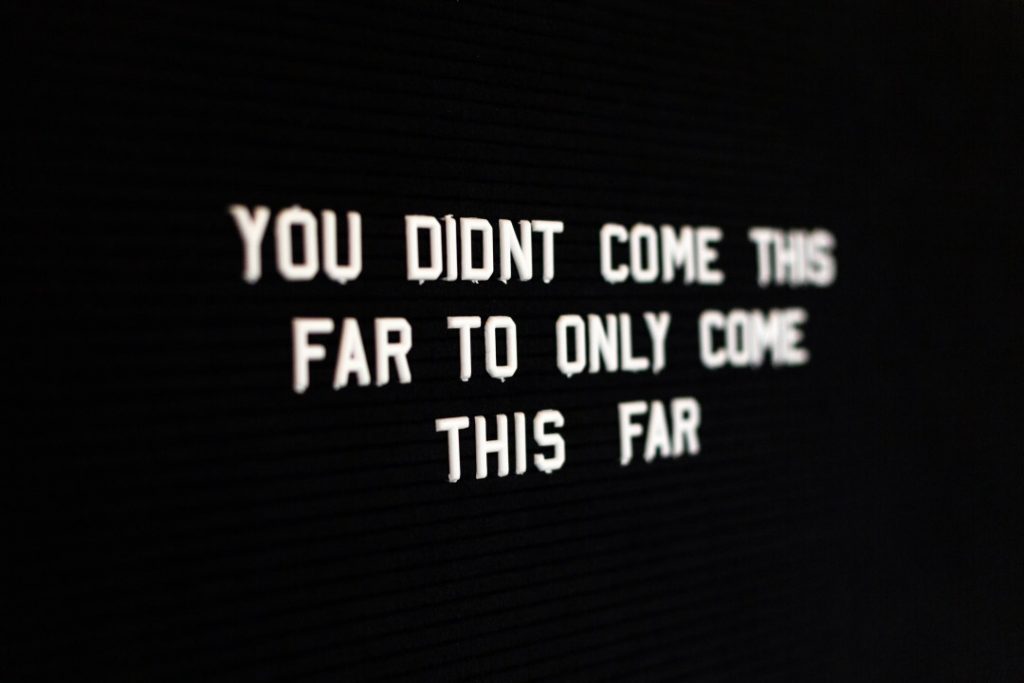
Similar to a question, a quote will leave a lasting impression with your audience.
Sometimes, what you want to be said has already been said in a profound way you can’t top and that’s ok. Adding a quote, especially an impactful quote from someone famous like Julius Caesar helps drive your point across.
9 – End With A Powerful Image

We all know the saying that a picture says a thousand words.
What better way to end a presentation with an image that can leave the audience with their own personalized conclusion.
Ending off with a powerful image lets your audience come to their own conclusion of the presentation. The image might be meaningful as it relates to the topic you’re presenting or might target a specific emotion you want to elicit from them.
10 – End With Clear Next Steps
Similar to a call to action, outlining clear next steps is important for ending a presentation.
Even when you might not require the audience to take action as you would when inputting a call to action, you might want to set clear steps for what you as the presenter will do, what the organization will do or what the audience as individuals will do in a business setting.
Outlining clear next steps holds everyone accountable and it makes things less ambiguous.
You may consider outlining next steps typically in a business presentation.
For example, if you’re pitching to a client on some business you hope for them to buy into, providing a timeline will help put them in a mindset that makes them believe they’re already working with you. Next steps could be what to expect once the contract is signed with clear deliverable dates.
If you’re still not sure on how to end your presentation, consider outsourcing your presentation design to an agency like Presentation Geeks that have years of experience crafting presentations for a variety of industries.
By trusting professional presentation designers, you can be assured that from beginning to end, your presentation will be one to remember and you’ll be on your way to becoming a better presenter .
Author: Ryan
Related posts.

FREE PROFESSIONAL RESOURCES DELIVERED TO YOUR INBOX.
Subscribe for free tips, resources, templates, ideas and more from our professional team of presentation designers.

SpeakUp resources
How to end a presentation in english: methods and examples.
- By Matthew Jones
Naturally, the way you end a presentation will depend on the setting and subject matter. Are you pitching an idea to your boss? Are you participating in a group presentation at school? Or are you presenting a business idea to potential investors? No matter the context, you’ll want to have a stellar ending that satisfies your audience and reinforces your goals.
So, do you want to learn how to end a presentation with style? Wondering how to end an informative speech? Or do you want to know how to conclude a Powerpoint presentation with impact? We’re here to help you learn how to end a presentation and make a great impression!
How to End a Presentation: 3 Effective Methods
Every presentation needs a great beginning, middle, and end. In this guide, we will focus on crafting the perfect conclusion. However, if you’d like to make sure that your presentation sounds good from start to finish, you should also check out our guide on starting a presentation in English .
Though there are many ways to end a presentation, the most effective strategies focus on making a lasting impression on your audience and reinforcing your goals. So, let’s take a look at three effective ways to end a presentation:
1. Summarize the Key Takeaways
Most presenters either make an argument (i.e. they want to convince their audience to adopt their view) or present new or interesting information (i.e. they want to educate their audience). In either case, the presentation will likely consist of important facts and figures. The conclusion gives you the opportunity to reiterate the most important information to your audience.
This doesn’t mean that you should simply restate everything from your presentation a second time. Instead, you should identify the most important parts of your presentation and briefly summarize them.
This is similar to what you might find in the last paragraph of an academic essay. For example, if you’re presenting a business proposal to potential investors, you might conclude with a summary of your business and the reasons why your audience should invest in your idea.
2. End with a CTA (Call-To-Action)
Ending with a Call-To-Action is one of the best ways to increase audience engagement (participation) with your presentation. A CTA is simply a request or invitation to perform a specific action. This technique is frequently used in sales or marketing presentations, though it can be used in many different situations.
For example, let’s say that you’re giving an informational presentation about the importance of hygiene in the workplace. Since your goal is to educate your audience, you may think that there’s no place for a CTA.
On the contrary, informational presentations are perfect for CTA’s. Rather than simply ending your presentation, you can direct your audience to seek out more information on the subject from authorities. In this case, you might encourage listeners to learn more from an authoritative medical organization, like the World Health Organization (WHO).
3. Use a Relevant Quote
It may sound cliche, but using quotes in your closing speech is both memorable and effective. However, not just any quote will do. You should always make sure that your quote is relevant to the topic. If you’re making an argument, you might want to include a quote that either directly or indirectly reinforces your main point.
Let’s say that you’re conducting a presentation about your company’s mission statement. You might present the information with a Powerpoint presentation, in which case your last slide could include an inspirational quote. The quote can either refer to the mission statement or somehow reinforce the ideas covered in the presentation.
Formatting Your Conclusion
While these 3 strategies should give you some inspiration, they won’t help you format your conclusion. You might know that you want to end your presentation with a Call-To-Action, but how should you “start” your conclusion? How long should you make your conclusion? Finally, what are some good phrases to use for ending a presentation?<br>
Examples of a Good Conclusion
In conclusion, I believe that we can increase our annual revenue this year. We can do this with a combination of increased efficiency in our production process and a more dynamic approach to lead generation. If we implement these changes, I estimate that annual revenue will increase by as much as 15%.
The example above shows a good conclusion for a business presentation. However, some people believe that the term in conclusion is overused. Here’s how to end a presentation using transition words similar to in conclusion .
Transition words help your audience know that your presentation is ending. Try starting your conclusion with one of these phrases:
- To summarize
However, transition words aren’t always necessary. Here are a few good ways to end a presentation using a different approach.
- Summarize Key Takeaways : There are two things that I’d like you to remember from today’s presentation. First, we are a company that consults startups for a fraction of the cost of other consultation services. And second, we have a perfect record of successfully growing startups in a wide variety of industries. If anything was unclear, I’d be happy to open the floor to questions.
- Make a Call-To-Action : I am very passionate about climate change. The future of the planet rests on our shoulders and we are quickly running out of time to take action. That said, I do believe that we can effect real change for future generations. I challenge you to take up the fight for our children and our children’s children.
- Use a Relevant Quote: I’d like to end my presentation with one of my favorite quotes: “Ask not what your country can do for you — ask what you can do for your country.”
As you can see, your conclusion does not need to be very long. In fact, a conclusion should be short and to the point. This way, you can effectively end your presentation without rambling or adding extraneous (irrelevant) information.
How to End a Presentation in English with Common Phrases
Finally, there are a few generic phrases that people frequently use to wrap up presentations. While we encourage you to think about how to end a presentation using a unique final statement, there’s nothing wrong with using these common closing phrases:
- Thank you for your time.
- I appreciate the opportunity to speak with you today.
- I’ll now answer any questions you have about (topic).
- If you need any further information, feel free to contact me at (contact information).
We hope this guide helps you better understand how to end a presentation ! If you’d like to find out more about how to end a presentation in English effectively, visit Magoosh Speaking today!
Matthew Jones

Free practice (Facebook group)
Phone: +1 (510) 560-7571
Terms of Use
Privacy Policy
Company Home

Improve your practice.
Enhance your soft skills with a range of award-winning courses.
Different Ways to End a Presentation or Speech
November 6, 2017 - Dom Barnard
The beginning and ending of your presentation are the most important. The beginning is where you grab the audience’s attention and ensure they listen to the rest of your speech. The conclusion gives you a chance to leave a lasting impression that listeners take away with them.
Studies show that when people are tasked with recalling information, they “best performance at the beginning and end”. It’s therefore essential you leave an impact with your closing statement. A strong ending motivates, empowers and encourages people to take action.
The power of three
The rule of three is a simple yet powerful method of communication and we use it often in both written and verbal communication. Using information in patterns of three makes it more memorable for the audience.
Examples of the power of three being used:
- This is not the end. It is not even the beginning of the end. But it is, perhaps, the end of the beginning – Winston Churchill
- Blood, sweat and tears – General Patton
- I came, I saw, I conquered – Julius Caesar
A compelling story
Ending your presentation on a short story, especially if that story is personal or illustrates how the content presented affects others is the best way to conclude.
If you want to talk about a customer experience or successful case study, think about how you can turn it into a meaningful story which the audience will remember and even relate to. Creating empathy with your audience and tying the story back to points made throughout the presentation ensures your presentation will be well received by the audience.
A surprising fact
A surprising fact has the power to re-engage the audience’s attention, which is most likely to wane by the end of a presentation. Facts with statistical numbers in them work well – you can easily search online for facts related to your speech topic. Just make use you remember the source for the fact in case you are questioned about it.
A running clock
Marketing and advertising executive Dietmar Dahmen ends his Create Your Own Change talk with a running clock to accompany his last statement. “Users rule,” he says, “so stop waiting and start doing. And you have to do that now because time is running out.”
If you’re delivering a time-sensitive message, where you want to urge your listeners to move quickly, you can have a background slide with a running timer to add emphasis to your last statement.

Acknowledging people or companies
There are times when it’s appropriate to thank people publicly for helping you – such as
- Presenting a research paper and want to thank people involved in the project
- Presenting data or information obtained from a company or a person
- When someone helped you build the presentation if it’s a particularly complex one
You can even use the PowerPoint credits feature for additional ‘wow’ factor.
A short, memorable sentence
A sound bite is an attention magnet. It cuts to the core of your central message and is one of the most memorable takeaways for today’s Twitter-sized attention spans. Consider Steve Jobs’ famous last line at his commencement address at Stanford University: “Stay hungry, stay foolish.”
Think about how you can distil your message down to a crisp, memorable statement. Does it represent your authentic voice? Does it accurately condense what your core message is about? Listeners, especially business audiences, have a radar that quickly spots an effort to impress rather than to genuinely communicate an important message.
An interesting quote
A relatively easy way to end your speech is by using a quote. For this to be effective, however, the quote needs to be one that has not been heard so often that it has become cliché.
To access fresh quotes, consider searching current personalities rather than historical figures. For example, a quote on failing from J.K. Rowling: “It is impossible to live without failing at something, unless you live so cautiously that you might as well not have lived at all – in which case, you fail by default.”
You need to figure out what resonates with your audience, and choose a quote that fits the presentation theme. If you’re up to it, you can round off the quote with your own thoughts as well.
A visual image
Make use of this power by ending your presentation with a riveting visual that ties to your take-home message. Leave this slide on when you finish your presentation to give the audience something to look at and think about for the next few minutes.
Use a summary slide instead of a ‘thank you’ slide
‘Thank You’ slides don’t really help the audience. You should be verbally saying ‘Thank you’, with a smile and with positive eye contact, putting it on a slide removes the sentiment.
Instead of a ‘Thank You’ slide, you can use a summary slide showing all the key points you have made along with your call to action. It can also show your name and contact details.
This slide is the only slide you use that can contain a lot of text, use bullet points to separate the text. Having all this information visible during the Q&A session will also help the audience think of questions to ask you. They may also choose to take photos of this slide with their phone to take home as a summary of your talk and to have your contact details.

Repeat something from the opening
Closing a presentation with a look back at the opening message is a popular technique. It’s a great way to round off your message, whilst simultaneously summing up the entire speech and creating a feeling of familiarity for the audience. Comedians do this well when they tie an earlier joke to a later one.
Doing this will signal to the audience that you are coming to the end of your talk. It completes the circle – you end up back where you started.
There are a few ways to approach this technique:
- Set up a question at the beginning of your speech and use your ending to answer it
- Finish a story you started, using the anecdote to demonstrate your message
- Close with the title of the presentation – this works best with a provocative, memorable title
Link the main points to the key message
At the beginning of your talk, it’s important to map out the main ideas you will talk about. An audience that doesn’t know the stages of the journey you are about to take them on will be less at ease than one that knows what lies ahead. At the end of your talk, take them back over what you’ve spoken about but don’t just list the different ideas you developed, show how they are related and how they support your main argument.
Finish with enthusiasm
It’s only natural that you’ll feel tired when you get to the end of your talk. The adrenaline that was racing through your body at the beginning has now worn off.
It’s crucial that the audience feels that you are enthusiastic and open for questions. If you’re not enthusiastic about the presentation, why should the audience be?
Practice Presentation Skills
Improve your public speaking and presentation skills by practicing them in realistic environments, with automated feedback on performance. Learn More
Don’t end with audience questions
When the Q&A session is over, stand up, get their attention and close the presentation. In your closing give your main argument again, your call to action and deal with any doubts or criticisms that out in the Q&A.
A closing is more or less a condensed version of your conclusions and an improvised summary of the Q&A. It’s important that the audience goes home remembering the key points of the speech, not with a memory of a Q&A that may or may not have gone well or may have been dominated by someone other than you.
If possible, try and take questions throughout your presentation so they remain pertinent to the content.
Getting rid of the “questions?” slide
To start, let’s talk about what you shouldn’t do. You shouldn’t end a presentation with a slide that asks “Questions?” Everyone does and there is nothing memorable about this approach.
Ideally, you should take questions throughout the presentation so that the question asked and the answer given is relevant to the content presented. If you choose to take questions at the end of your presentation, end instead with a strong image that relates to your presentation’s content.
Worried about no audience questions?
If you’re afraid of not getting any questions, then you can arrange for a friend in the audience to ask one. The ‘plant’ is a good way to get questions started if you fear silence.
Chances are that people do want to ask questions, but no one wants to be the first to ask a question. If you don’t have a ‘plant’, you might need to get the ball rolling yourself. A good way to do this is for you to ask am open question to the audience. Ask the most confident looking person in the room for their opinion, or get the audience to discuss the question with the person sitting beside them.
A cartoon or animation
In his TED talk on The Paradox of Choice , Barry Schwartz ends his presentation with a cartoon of a fishbowl with the caption, “You can be anything you want to be – no limits.” He says, “If you shatter the fishbowl, so that everything is possible, you don’t have freedom, you have paralysis… Everybody needs a fishbowl”. This is a brilliant ending that combines visuals, humour and a metaphor. Consider ending your presentation with a relevant cartoon to make your message memorable.
Ask a rhetoric question
So, for example, if you’re finishing up a talk on the future of engineering, you might say, “I’d like to end by asking you the future of manufacturing, will it be completely taken over by robots in the next 30 years?”
The minute you ask a question , listeners are generally drawn into thinking about an answer. It’s even more engaging when the question is provocative, or when it touches potentially sensitive areas of our lives
Thank the audience
The simplest way to end a speech, after you’ve finished delivering the content, is to say, “thank you.” That has the benefit of being understood by everyone.
It’s the great way for anyone to signal to the audience that it’s time to applaud and then head home.
Call your audience to action and make it clear
It’s not enough to assume your message will inspire people to take action. You need to actually tell them to take action. Your call to action should be clear and specific. Your audience should be left with no doubt about what it is you’re asking.
Use the last few minutes of the presentation to reinforce the call to action you seek. Examples of strong calls to actions include:
- Retain 25% more employees with our personal development solution
- Save your business 150% by using this framework
- Donate today to save millions around the world
Make it clear that you’ve finished
Nothing is more uncomfortable than the silence of an audience working out if you’ve finished or not.
Your closing words should make it very clear that it’s the end of the presentation. The audience should be able to read this immediately, and respond. As we mentioned previously, saying “thank you” is a good way to finish.
If the applause isn’t forthcoming, stand confidently and wait. Don’t fidget and certainly don’t eke out a half-hearted, ‘And that just about covers it. Thank you’.
- Student Login:

How to Close Your Presentation in English Powerfully [+ FREE Presentation Checklist]
May 9, 2018 | Business Professional English , Free Resource , Public Speaking & Presentations

This lesson has been updated from its original posting in 2016.
You’re giving your presentation in English. You have just two minutes left. And it’s time for the conclusion …
Did you know most people only remember the first and last things you tell them? It’s true.
If you are giving a presentation in English, then you definitely want people to remember what you say at the end. And this means your closing must be powerful!
You’ve worked hard on your presentation. You searched for information online. You couldn’t sleep at night. You felt nervous about making mistakes. You spent hours preparing. You reviewed the grammar and vocabulary. You worried about someone asking a question. You practiced and practiced and practiced.
And now it’s the last two minutes. This is the last opportunity for your audience to hear your key points. It is the last chance you have to help your audience remember your comments.
A closing in a presentation should be short and clear. It should summarize your key points. And, most importantly, it should be powerful.
In today’s lesson, you’re going to learn about 3 ways to make your closing more powerful. Plus you’ll learn useful key expressions you can use in your presentation.
3 steps to a powerful closing in your presentation.
Lesson by Annemarie
3 Strategies to Close Your Presentation Powerfully
Use these 3 strategies in your conclusion to:
- recapture your audience’s attention
- get your audience to focus and remember your key points
- help your audience connect with you and your topic
- end your presentation powerfully
One: Include a Call to Action (CTA)
Is there something you want your audience to do or think after your presentation. Do you want them to take action? Tell your audience exactly what you want them to do with a Call to Action.
Here’s my example:
“ After you finish today’s lesson, please take 2 minutes to leave a comment about your experience with presentations. You can share your thoughts or ask questions in the comments section at the bottom of this lesson – it’s the perfect place to join a discussion on this topic.”
A couple useful expressions to help you introduce your CTA is:
- To close, I’d like to ask you to do this one thing…
- And finally, before you leave the conference today, please take two minutes to…
Two: End with a Powerful/Inspirational Quote
Is there one thing you really want your audience to remember? Or is there a specific feeling you want your audience to have after your presentation?
Using a powerful quote can help you do that. You could introduce a great quote or interesting statistic with:
- I’d like to finish with this powerful/interesting/wonderful/inspiring/ quote from …
- And finally, let’s finish up today’s discussion with this surprising/useful/shocking/hopeful statistic …
Here are some example quotes that might help people be prepared to take action or to think differently. But remember! Always match the quote or statistic to your topic:
“In the end, we will remember not the words of our enemies, but the silence of our friends.” – Martin Luther King, Jr. “Sometimes we stare so long at a door that is closing that we see too late the one that is open.” – Alexander Graham Bell
Three: Add a Surprising Fact or Statistic
Is there something you’d love for your audience to think about after your presentation? Is there a statistic or fact that will help someone remember your key points?
A surprising fact can also help re-engage your audience, it will snap their attention back to you.
For example:
Did you know that the human brain’s capacity is limitless – that’s great new right? BUT … did you also know that a person is likely to remember only 25% of a presentation after 24 hours?
Uh oh. That is why it’s SO important to have a powerful ending! Remember: the key is to find a statistic or fact that connects directly to your topic.
Useful Language to Close Your Presentation
Summarize Your Key Points & Close Your Presentation
- That brings us to the end of the presentation. I’d like to summarize by saying …
- That concludes my presentation. However, I’d like to quickly summarize the main points or takeaways.
- And on that final note, that concludes my presentation.
- To quickly recap, I’d like you to remember these key points …
- To summarize …
- In conclusion …
- I’d like to bring this presentation to a close with …
- I’d like to close this talk with …
- So, this concludes the focus of discussion today. To end, I’d like to highlight …
- This concludes [name/title of the section] so let’s move on to the final comments.
Thank Your Audience
- I sincerely appreciate your attention today/this evening/this morning.
- And that brings us to the end. I’d like to thank you for your time and attention today.
- Thank you so much for your interest and attention.
- At this time, I’d like to have my colleague speak so I’ll finish up by saying thank you for your attention.
- I can see that our time is just about up so to finish I’d like to say thank you.
- I sincerely appreciate that I’ve had this opportunity to present to you.
- If there is one thing I would like you to remember from today’s presentation it’s …
Take Questions
- If anyone has any questions, I’d be happy to open up the discussion.
- If anyone has any questions, please feel free to ask now and I’ll do my best to answer.
- Would anyone like to ask any questions?
- I would now be interested to hear from you with your thoughts or questions.
- Now let’s move on to some Q&A. (Q&A = Questions and Answers)
Provide Next Steps or Contact Information
- If you would like more information, here is a list of useful resources/websites.
- If anyone who like more information or has questions, please feel free to contact me at: [include contact info]
- Here is a list for further reading on this topic. (Include the list of books or websites.)
Get the complete Presentations in English Series:
Part 1: How to Prepare for Your Presentation in English
Part 2: How to Start with a Great Introduction in Your Presentation
Part 3: How to Organize Your Presentation in English
Part 4: How to End Your Presentation Powerfully
After you’ve watched the video and reviewed the lesson, I’d love to hear from you!
Tell me about the best presentation you ever heard. Who gave the presentation? And why do you remember it? Share what you remember in the comments section below.
And for the bonus question!! Have you given a presentation in English? What tips or advice would you like to share with others? You can add your advice in the comments section.
Thank you so much for joining me!
~ Annemarie
Get the Confidence to Say What You Want in English
Follow my 3-step solution to speak English with clarity, fluency, and freedom so you can say what you want with confidence.
You'll also get my Confident English lessons delivered by email every Wednesday and occasional information about available courses. You can unsubscribe any time.
More Like This

5 Smart Questions to Ask in an English Job Interview
It’s the last question in your job interview in English and you hear: Do you have any questions for me? What should you say? Is it okay to ask a question in a job interview? Find out exactly what you should do plus 5 smart questions to ask.

How to Disagree in English Politely
Want to say “I disagree” without creating tension in the conversation? Master the art of disagreement in this lesson on, “How to Disagree in English Politely.”

#310: The Right Grammar for English Introductions
Get your English introductions just right with this step-by-step video on Grammar for English Introductions when you’re meeting someone new.

#309: How to Go Off Topic in English | English Conversation Skills
Learn how to gracefully go off topic in English without losing your audience. Whether you’re in a meeting or chatting with friends, in this lesson we dive deep into the art of smoothly navigating tangents while enhancing your English conversation skills.
![how to end a presentation properly #308: How to Use ‘Though’ in English [+ FREE Worksheet]](https://www.speakconfidentenglish.com/wp-content/uploads/2024/04/How-to-Use-Though-in-English-400x250.png)
#308: How to Use ‘Though’ in English [+ FREE Worksheet]
Learn and practice how to correctly use though, although, even though, and as thought in your English conversations.

#307: How to Use English Abbreviations in Emails, Texts, and Conversations
Follow this comprehensive guide to learn how to use English abbreviations for emails, texts, and conversations.
© Copyright 2014-2024 Speak Confident English | Privacy Policy | Terms & Disclaimer | Online Class Policies
I’m glad to hear it was helpful!
This was very helpful
Thanks, Ma’am/Sir. This helped me a lot…
Same here ma’am
This is so helpful. Thank you so much
This helped a lot. Thank you so much <3
I accidentally found your page while working on my English video presentation. It’s really helpful. Thanks soooo much 🙂
I’m very glad to know it was helpful!
Hi! I found your page very insightful. Thank you very much!
I’m glad to hear it!
great video series. thank you so much. you mentioned that you had a downloadable checklist in the final video. where could I find this thanks?
Hi Ellie, I’m glad the series was helpful.
When you visit the lesson, there should be an image that pops up with an opportunity to get the download. If you don’t see it, please let me know so I can fix it.
Helped a lot! Thank you very much <33
thank you so much
I love your method
Hello, I have a 5 minute oral presentation of a fictional book, w/the main focus on the leadership traits of the characters. I enjoyed the book, and suspect others might, so to that end, is it OK to NOT share the ending? Thank you
Thanks for your help 🙂
Great website. I found a typo in on the presentation closings page “Useful Langauge to Close Your Presentation”.
Good eyes! Thanks so much for the note. We’ve fixed the typo.
Dear Annemarie, thank you so much for sharing.
Dear Annemarie, thank you so much for sharing. I learned so much from your 4 videos and I will work on improving my presentation skills. Love your spirit of excellence. For me as a presenter, its important i am passionate about the topic i share and audience will be able to apply some of the learnings in their life. Thank you Annemarie. I love your voice too. Stay blessed.
I watch continuously watched ur 4 videos and U r a great teacher.Thanks for making such purposeful videos.
I am so happy , I have more form you thank you very much
You are absolutely wonderful and your website is extremely useful and also quit impressive i habe my english A-levels in December i copied this text i sinisterly appreciate that i have had this opportunity to present to you and i also add something * it was a honor for me so thank you ☺️
Thanks, Jasmin! I’m so glad to know my lessons are helpful to you.
hey Annemarie could you help me in ending my presentation on mental health. it is a school presentation for MUN
If you’d like editing help, please see our options for 1:1 classes .
You are my favorite speaker. ☺
Hi Anna, that’s so kind of you. Thank you. 🙂
It’s so useful to us…… I’m so happy by this
I’m glad it was helpful to you, Kalpana.
I was holistically stuck about how to give my first ever presentation, but this gave me an impetus and confidence. Thanks a lot for this exquisite info
Awesome. I’m glad this helped you to move forward.
Thank YOU for tour tips. They are really inspiring. I Will try to put them into practise.
Hi Nancy, Wonderful! I’m glad they’re helpful to you!
It’s so useful to us…… I’m so happy by this
do you have Presentation course
Hi Hammad, I don’t at this time but it’s definitely something I’m thinking about.
Pin It on Pinterest
We use essential cookies to make Venngage work. By clicking “Accept All Cookies”, you agree to the storing of cookies on your device to enhance site navigation, analyze site usage, and assist in our marketing efforts.
Manage Cookies
Cookies and similar technologies collect certain information about how you’re using our website. Some of them are essential, and without them you wouldn’t be able to use Venngage. But others are optional, and you get to choose whether we use them or not.
Strictly Necessary Cookies
These cookies are always on, as they’re essential for making Venngage work, and making it safe. Without these cookies, services you’ve asked for can’t be provided.
Show cookie providers
- Google Login
Functionality Cookies
These cookies help us provide enhanced functionality and personalisation, and remember your settings. They may be set by us or by third party providers.
Performance Cookies
These cookies help us analyze how many people are using Venngage, where they come from and how they're using it. If you opt out of these cookies, we can’t get feedback to make Venngage better for you and all our users.
- Google Analytics
Targeting Cookies
These cookies are set by our advertising partners to track your activity and show you relevant Venngage ads on other sites as you browse the internet.
- Google Tag Manager
- Infographics
- Daily Infographics
- Popular Templates
- Accessibility
- Graphic Design
- Graphs and Charts
- Data Visualization
- Human Resources
- Beginner Guides
Blog Beginner Guides How To Make a Good Presentation [A Complete Guide]
How To Make a Good Presentation [A Complete Guide]
Written by: Krystle Wong Jul 20, 2023

A top-notch presentation possesses the power to drive action. From winning stakeholders over and conveying a powerful message to securing funding — your secret weapon lies within the realm of creating an effective presentation .
Being an excellent presenter isn’t confined to the boardroom. Whether you’re delivering a presentation at work, pursuing an academic career, involved in a non-profit organization or even a student, nailing the presentation game is a game-changer.
In this article, I’ll cover the top qualities of compelling presentations and walk you through a step-by-step guide on how to give a good presentation. Here’s a little tip to kick things off: for a headstart, check out Venngage’s collection of free presentation templates . They are fully customizable, and the best part is you don’t need professional design skills to make them shine!
These valuable presentation tips cater to individuals from diverse professional backgrounds, encompassing business professionals, sales and marketing teams, educators, trainers, students, researchers, non-profit organizations, public speakers and presenters.
No matter your field or role, these tips for presenting will equip you with the skills to deliver effective presentations that leave a lasting impression on any audience.
Click to jump ahead:
What are the 10 qualities of a good presentation?
Step-by-step guide on how to prepare an effective presentation, 9 effective techniques to deliver a memorable presentation, faqs on making a good presentation, how to create a presentation with venngage in 5 steps.
When it comes to giving an engaging presentation that leaves a lasting impression, it’s not just about the content — it’s also about how you deliver it. Wondering what makes a good presentation? Well, the best presentations I’ve seen consistently exhibit these 10 qualities:
1. Clear structure
No one likes to get lost in a maze of information. Organize your thoughts into a logical flow, complete with an introduction, main points and a solid conclusion. A structured presentation helps your audience follow along effortlessly, leaving them with a sense of satisfaction at the end.
Regardless of your presentation style , a quality presentation starts with a clear roadmap. Browse through Venngage’s template library and select a presentation template that aligns with your content and presentation goals. Here’s a good presentation example template with a logical layout that includes sections for the introduction, main points, supporting information and a conclusion:

2. Engaging opening
Hook your audience right from the start with an attention-grabbing statement, a fascinating question or maybe even a captivating anecdote. Set the stage for a killer presentation!
The opening moments of your presentation hold immense power – check out these 15 ways to start a presentation to set the stage and captivate your audience.
3. Relevant content
Make sure your content aligns with their interests and needs. Your audience is there for a reason, and that’s to get valuable insights. Avoid fluff and get straight to the point, your audience will be genuinely excited.
4. Effective visual aids
Picture this: a slide with walls of text and tiny charts, yawn! Visual aids should be just that—aiding your presentation. Opt for clear and visually appealing slides, engaging images and informative charts that add value and help reinforce your message.
With Venngage, visualizing data takes no effort at all. You can import data from CSV or Google Sheets seamlessly and create stunning charts, graphs and icon stories effortlessly to showcase your data in a captivating and impactful way.

5. Clear and concise communication
Keep your language simple, and avoid jargon or complicated terms. Communicate your ideas clearly, so your audience can easily grasp and retain the information being conveyed. This can prevent confusion and enhance the overall effectiveness of the message.
6. Engaging delivery
Spice up your presentation with a sprinkle of enthusiasm! Maintain eye contact, use expressive gestures and vary your tone of voice to keep your audience glued to the edge of their seats. A touch of charisma goes a long way!
7. Interaction and audience engagement
Turn your presentation into an interactive experience — encourage questions, foster discussions and maybe even throw in a fun activity. Engaged audiences are more likely to remember and embrace your message.
Transform your slides into an interactive presentation with Venngage’s dynamic features like pop-ups, clickable icons and animated elements. Engage your audience with interactive content that lets them explore and interact with your presentation for a truly immersive experience.

8. Effective storytelling
Who doesn’t love a good story? Weaving relevant anecdotes, case studies or even a personal story into your presentation can captivate your audience and create a lasting impact. Stories build connections and make your message memorable.
A great presentation background is also essential as it sets the tone, creates visual interest and reinforces your message. Enhance the overall aesthetics of your presentation with these 15 presentation background examples and captivate your audience’s attention.
9. Well-timed pacing
Pace your presentation thoughtfully with well-designed presentation slides, neither rushing through nor dragging it out. Respect your audience’s time and ensure you cover all the essential points without losing their interest.
10. Strong conclusion
Last impressions linger! Summarize your main points and leave your audience with a clear takeaway. End your presentation with a bang , a call to action or an inspiring thought that resonates long after the conclusion.
In-person presentations aside, acing a virtual presentation is of paramount importance in today’s digital world. Check out this guide to learn how you can adapt your in-person presentations into virtual presentations .

Preparing an effective presentation starts with laying a strong foundation that goes beyond just creating slides and notes. One of the quickest and best ways to make a presentation would be with the help of a good presentation software .
Otherwise, let me walk you to how to prepare for a presentation step by step and unlock the secrets of crafting a professional presentation that sets you apart.
1. Understand the audience and their needs
Before you dive into preparing your masterpiece, take a moment to get to know your target audience. Tailor your presentation to meet their needs and expectations , and you’ll have them hooked from the start!
2. Conduct thorough research on the topic
Time to hit the books (or the internet)! Don’t skimp on the research with your presentation materials — dive deep into the subject matter and gather valuable insights . The more you know, the more confident you’ll feel in delivering your presentation.
3. Organize the content with a clear structure
No one wants to stumble through a chaotic mess of information. Outline your presentation with a clear and logical flow. Start with a captivating introduction, follow up with main points that build on each other and wrap it up with a powerful conclusion that leaves a lasting impression.
Delivering an effective business presentation hinges on captivating your audience, and Venngage’s professionally designed business presentation templates are tailor-made for this purpose. With thoughtfully structured layouts, these templates enhance your message’s clarity and coherence, ensuring a memorable and engaging experience for your audience members.
Don’t want to build your presentation layout from scratch? pick from these 5 foolproof presentation layout ideas that won’t go wrong.

4. Develop visually appealing and supportive visual aids
Spice up your presentation with eye-catching visuals! Create slides that complement your message, not overshadow it. Remember, a picture is worth a thousand words, but that doesn’t mean you need to overload your slides with text.
Well-chosen designs create a cohesive and professional look, capturing your audience’s attention and enhancing the overall effectiveness of your message. Here’s a list of carefully curated PowerPoint presentation templates and great background graphics that will significantly influence the visual appeal and engagement of your presentation.
5. Practice, practice and practice
Practice makes perfect — rehearse your presentation and arrive early to your presentation to help overcome stage fright. Familiarity with your material will boost your presentation skills and help you handle curveballs with ease.
6. Seek feedback and make necessary adjustments
Don’t be afraid to ask for help and seek feedback from friends and colleagues. Constructive criticism can help you identify blind spots and fine-tune your presentation to perfection.
With Venngage’s real-time collaboration feature , receiving feedback and editing your presentation is a seamless process. Group members can access and work on the presentation simultaneously and edit content side by side in real-time. Changes will be reflected immediately to the entire team, promoting seamless teamwork.

7. Prepare for potential technical or logistical issues
Prepare for the unexpected by checking your equipment, internet connection and any other potential hiccups. If you’re worried that you’ll miss out on any important points, you could always have note cards prepared. Remember to remain focused and rehearse potential answers to anticipated questions.
8. Fine-tune and polish your presentation
As the big day approaches, give your presentation one last shine. Review your talking points, practice how to present a presentation and make any final tweaks. Deep breaths — you’re on the brink of delivering a successful presentation!
In competitive environments, persuasive presentations set individuals and organizations apart. To brush up on your presentation skills, read these guides on how to make a persuasive presentation and tips to presenting effectively .

Whether you’re an experienced presenter or a novice, the right techniques will let your presentation skills soar to new heights!
From public speaking hacks to interactive elements and storytelling prowess, these 9 effective presentation techniques will empower you to leave a lasting impression on your audience and make your presentations unforgettable.
1. Confidence and positive body language
Positive body language instantly captivates your audience, making them believe in your message as much as you do. Strengthen your stage presence and own that stage like it’s your second home! Stand tall, shoulders back and exude confidence.
2. Eye contact with the audience
Break down that invisible barrier and connect with your audience through their eyes. Maintaining eye contact when giving a presentation builds trust and shows that you’re present and engaged with them.
3. Effective use of hand gestures and movement
A little movement goes a long way! Emphasize key points with purposeful gestures and don’t be afraid to walk around the stage. Your energy will be contagious!
4. Utilize storytelling techniques
Weave the magic of storytelling into your presentation. Share relatable anecdotes, inspiring success stories or even personal experiences that tug at the heartstrings of your audience. Adjust your pitch, pace and volume to match the emotions and intensity of the story. Varying your speaking voice adds depth and enhances your stage presence.

5. Incorporate multimedia elements
Spice up your presentation with a dash of visual pizzazz! Use slides, images and video clips to add depth and clarity to your message. Just remember, less is more—don’t overwhelm them with information overload.
Turn your presentations into an interactive party! Involve your audience with questions, polls or group activities. When they actively participate, they become invested in your presentation’s success. Bring your design to life with animated elements. Venngage allows you to apply animations to icons, images and text to create dynamic and engaging visual content.
6. Utilize humor strategically
Laughter is the best medicine—and a fantastic presentation enhancer! A well-placed joke or lighthearted moment can break the ice and create a warm atmosphere , making your audience more receptive to your message.
7. Practice active listening and respond to feedback
Be attentive to your audience’s reactions and feedback. If they have questions or concerns, address them with genuine interest and respect. Your responsiveness builds rapport and shows that you genuinely care about their experience.

8. Apply the 10-20-30 rule
Apply the 10-20-30 presentation rule and keep it short, sweet and impactful! Stick to ten slides, deliver your presentation within 20 minutes and use a 30-point font to ensure clarity and focus. Less is more, and your audience will thank you for it!
9. Implement the 5-5-5 rule
Simplicity is key. Limit each slide to five bullet points, with only five words per bullet point and allow each slide to remain visible for about five seconds. This rule keeps your presentation concise and prevents information overload.
Simple presentations are more engaging because they are easier to follow. Summarize your presentations and keep them simple with Venngage’s gallery of simple presentation templates and ensure that your message is delivered effectively across your audience.

1. How to start a presentation?
To kick off your presentation effectively, begin with an attention-grabbing statement or a powerful quote. Introduce yourself, establish credibility and clearly state the purpose and relevance of your presentation.
2. How to end a presentation?
For a strong conclusion, summarize your talking points and key takeaways. End with a compelling call to action or a thought-provoking question and remember to thank your audience and invite any final questions or interactions.
3. How to make a presentation interactive?
To make your presentation interactive, encourage questions and discussion throughout your talk. Utilize multimedia elements like videos or images and consider including polls, quizzes or group activities to actively involve your audience.
In need of inspiration for your next presentation? I’ve got your back! Pick from these 120+ presentation ideas, topics and examples to get started.
Creating a stunning presentation with Venngage is a breeze with our user-friendly drag-and-drop editor and professionally designed templates for all your communication needs.
Here’s how to make a presentation in just 5 simple steps with the help of Venngage:
Step 1: Sign up for Venngage for free using your email, Gmail or Facebook account or simply log in to access your account.
Step 2: Pick a design from our selection of free presentation templates (they’re all created by our expert in-house designers).
Step 3: Make the template your own by customizing it to fit your content and branding. With Venngage’s intuitive drag-and-drop editor, you can easily modify text, change colors and adjust the layout to create a unique and eye-catching design.
Step 4: Elevate your presentation by incorporating captivating visuals. You can upload your images or choose from Venngage’s vast library of high-quality photos, icons and illustrations.
Step 5: Upgrade to a premium or business account to export your presentation in PDF and print it for in-person presentations or share it digitally for free!
By following these five simple steps, you’ll have a professionally designed and visually engaging presentation ready in no time. With Venngage’s user-friendly platform, your presentation is sure to make a lasting impression. So, let your creativity flow and get ready to shine in your next presentation!
Discover popular designs

Infographic maker

Brochure maker

White paper online

Newsletter creator

Flyer maker

Timeline maker

Letterhead maker

Mind map maker

Ebook maker
- SUGGESTED TOPICS
- The Magazine
- Newsletters
- Managing Yourself
- Managing Teams
- Work-life Balance
- The Big Idea
- Data & Visuals
- Reading Lists
- Case Selections
- HBR Learning
- Topic Feeds
- Account Settings
- Email Preferences
What It Takes to Give a Great Presentation
- Carmine Gallo

Five tips to set yourself apart.
Never underestimate the power of great communication. It can help you land the job of your dreams, attract investors to back your idea, or elevate your stature within your organization. But while there are plenty of good speakers in the world, you can set yourself apart out by being the person who can deliver something great over and over. Here are a few tips for business professionals who want to move from being good speakers to great ones: be concise (the fewer words, the better); never use bullet points (photos and images paired together are more memorable); don’t underestimate the power of your voice (raise and lower it for emphasis); give your audience something extra (unexpected moments will grab their attention); rehearse (the best speakers are the best because they practice — a lot).
I was sitting across the table from a Silicon Valley CEO who had pioneered a technology that touches many of our lives — the flash memory that stores data on smartphones, digital cameras, and computers. He was a frequent guest on CNBC and had been delivering business presentations for at least 20 years before we met. And yet, the CEO wanted to sharpen his public speaking skills.
- Carmine Gallo is a Harvard University instructor, keynote speaker, and author of 10 books translated into 40 languages. Gallo is the author of The Bezos Blueprint: Communication Secrets of the World’s Greatest Salesman (St. Martin’s Press).
Partner Center

COMMENTS
30 Example Phrases: How to Conclude a Presentation. 1. "In summary, let's revisit the key takeaways from today's presentation.". 2. "Thank you for your attention. Let's move forward together.". 3. "That brings us to the end. I'm open to any questions you may have.".
But how you end it can make all the difference in your presentation's overall impact. Here are some ways to ensure you end powerfully: Way #1: Include a Strong Call-to-Action (CTA) Way #2: Don't End With a Q&A. Way #3: End With a Memorable Quote. Way #4: Close With a Story. Way #5: Drive Your Main Points Home.
Here are some tips for using a story to conclude a presentation: Make sure the story is brief. Choose a story that relates to the main points of the presentation. Stories about a customer experience or successful case study are effective. Make sure the story is relatable and encourages empathy from your audience. 7.
Summarize and show a sneak peek. Make a lasting impact: quotes. Use emotions to persuade your audience. Involve your audience. Add a "Thanks!" slide. Summarize and show a sneak peek. Just before saying "thanks" and "goodbye", it's time to summarize the contents of your presentation… and give something new to your audience.
9. Close with a powerful visual. Sometimes, visuals can say much more than words. If you want to end your presentation with a powerful note, show an image, drawing, short video clip, or another type of visual that ties in with your message. Visuals can help your audience retain information.
12. Use the title close technique. Another useful technique for how to end a presentation is to use the title of your presentation as the closing words. This creates a bookend to your entire presentation and can be used to bring your audience full circle. See the tip about coming full circle above. 13.
How to End a Presentation: 5 Ways to End a Presentation. While all aspects of a business presentation are important, the end of the presentation can determine whether you leave a lasting impression on your audience. Learn public speaking tips and some key takeaways for how to end your presentation.
HBR's direct piece of advice is that you should "use the last few moments of your presentation to clarify what action [an audience] can take to show their support.". And what's key to HBR is that you "Also mention your timeframe" as, for them, "a deadline can help to urge [the audience] into action.".
8. Ask for feedback: You can conclude your presentation seamlessly by thanking the audience and asking for feedback from them. Encouraging feedback from your audience can greatly benefit your future presentations. It allows you to understand how your message was received and how you can improve for the next time.
So let's look at some tips first of all. Run a live poll. Call them to action. Reverse icebreaker. A strong summary. Give them a survey. Avoid a Q&A. End with a story & infographic. Show a visual or short video.
6 great ways to close your presentation. Six ways to effectively close your presentation are: 1. A short summary. Simple, straightforward and effective. For example, if your presentation has three ...
Give your audience actions to help share your message. 7. Promote your upcoming events or workshops. 8. Asking your audience to become a volunteer. 9. Direct your audience to learn more about your website. 10. If you are a book author, encourage your audience to engage with your book.
Doing so not only summarizes the presentation, but also completes the circle of the topic, connecting back to the start. If a question was posed in the opening, it can be answered in the takeaway. It can also be a prime opportunity to explain the moral of a story told earlier in the presentation. 7. End with an ask.
Decide on Your Close. The first step is to decide what type of close and call to action you'll use for your presentation. For the purposes of this tutorial, I'll use a persuasive close with numbers that back up the ideas presented in the presentation. Slide #13 from the Yukee template fits perfectly for this occasion.
10 Ways To End Your Business Presentation & PowerPoint Presentation. 1 - End With A Call To Action. 2 - End With A Compelling Story. 3 - Avoid Q&As. Alternative Ways To Get The Audience's Attention, Feedback and Increase Engagement. 4 - Come Full Circle With Your Message. 5 - Demonstrate Your Product.
Though there are many ways to end a presentation, the most effective strategies focus on making a lasting impression on your audience and reinforcing your goals. So, let's take a look at three effective ways to end a presentation: 1. Summarize the Key Takeaways. Most presenters either make an argument (i.e. they want to convince their ...
There are a few ways to approach this technique: Set up a question at the beginning of your speech and use your ending to answer it. Finish a story you started, using the anecdote to demonstrate your message. Close with the title of the presentation - this works best with a provocative, memorable title.
Learn how to end a PowerPoint presentation with a strong close that inspires action. Watch this screencast and get tips from experts.
3 Strategies to Close Your Presentation Powerfully. Use these 3 strategies in your conclusion to: recapture your audience's attention. get your audience to focus and remember your key points. help your audience connect with you and your topic. end your presentation powerfully. One: Include a Call to Action (CTA)
In this video, you'll learn a really simple and effective way to end your presentation. I've taught you quite a few things about starting your presentations,...
Learn how to end a presentation properly by using one of the 5 most common ways to conclude a presentation as well as by applying some easy presentation ti...
Apply the 10-20-30 rule. Apply the 10-20-30 presentation rule and keep it short, sweet and impactful! Stick to ten slides, deliver your presentation within 20 minutes and use a 30-point font to ensure clarity and focus. Less is more, and your audience will thank you for it! 9. Implement the 5-5-5 rule. Simplicity is key.
Here are a few tips for business professionals who want to move from being good speakers to great ones: be concise (the fewer words, the better); never use bullet points (photos and images paired ...